#The play on the significance of names and existence and the role one plays in the world/notions of self I loved as well
Text
Automaton angel

#WHAT A CONCEPT#The imagery is soooo good#Anyway I caved. I've read the chapter without further context. I couldn't help it I loved the concepts it played with#Very Rufus the thing the guy with the brooch did at first. The panel of the archivist girl was so Lacie I could have kicked the wall#The play on the significance of names and existence and the role one plays in the world/notions of self I loved as well#And that is so 👀 when later on it's mentioned off-hand that... Olivier is actually named Romeo? Have I understood that well?#It was so cute that little throwback with him and Roland as kids. And that he knew of Astolfo meeting a friend but didn't tell due to that#And wow there was rape everywhere in this chapter? I didn't know Astolfo had been raped. I had heard about his... mother? sister?#But not him. I mean‚ maybe they were victims of sex-rape‚ but the talk about several vampires biting him and drinking his blood#and how the mark never leaves and how dirty and maimed in ever sense he feels sure seems to imply that at least metaphorically#The angel-like being also having gone through that is interesting again in its potential implications and ramifications. The very concept#Anyway... That pretty guy telling Astolfo that he knows what he's going through and recommending him to kill himself#because life is hell from that moment on... Wow he was so real and seemed so... sincere? But who knows. He sure is alive#That + the angel-like figure's words make it so intriguing given his position as chasseur? paladin? whatever the name was#Anyway I loved that he said that in any case#I liked Olivier on the verge of getting violent with the guy who was being a dick too I can't help it. Leave the kid alone#I'm rambling but yeah I loved the concept around this angel-like being both aesthetically and narratively for what we got#I talk too much#I should probably delete this later
8 notes
·
View notes
Text

LaRue Burbank, mathematician and computer, is just one of the many women who were instrumental to NASA missions.
4 Little Known Women Who Made Huge Contributions to NASA
Women have always played a significant role at NASA and its predecessor NACA, although for much of the agency’s history, they received neither the praise nor recognition that their contributions deserved. To celebrate Women’s History Month – and properly highlight some of the little-known women-led accomplishments of NASA’s early history – our archivists gathered the stories of four women whose work was critical to NASA’s success and paved the way for future generations.
LaRue Burbank: One of the Women Who Helped Land a Man on the Moon
LaRue Burbank was a trailblazing mathematician at NASA. Hired in 1954 at Langley Memorial Aeronautical Laboratory (now NASA’s Langley Research Center), she, like many other young women at NACA, the predecessor to NASA, had a bachelor's degree in mathematics. But unlike most, she also had a physics degree. For the next four years, she worked as a "human computer," conducting complex data analyses for engineers using calculators, slide rules, and other instruments. After NASA's founding, she continued this vital work for Project Mercury.
In 1962, she transferred to the newly established Manned Spacecraft Center (now NASA’s Johnson Space Center) in Houston, becoming one of the few female professionals and managers there. Her expertise in electronics engineering led her to develop critical display systems used by flight controllers in Mission Control to monitor spacecraft during missions. Her work on the Apollo missions was vital to achieving President Kennedy's goal of landing a man on the Moon.
Eilene Galloway: How NASA became… NASA
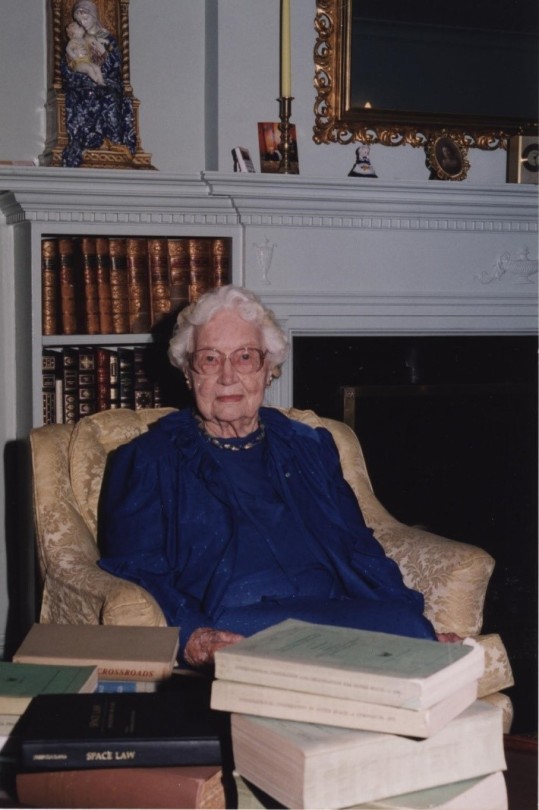
Eilene Galloway wasn't a NASA employee, but she played a huge role in its very creation. In 1957, after the Soviet Union launched Sputnik, Senator Richard Russell Jr. called on Galloway, an expert on the Atomic Energy Act, to write a report on the U.S. response to the space race. Initially, legislators aimed to essentially re-write the Atomic Energy Act to handle the U.S. space goals. However, Galloway argued that the existing military framework wouldn't suffice – a new agency was needed to oversee both military and civilian aspects of space exploration. This included not just defense, but also meteorology, communications, and international cooperation.
Her work on the National Aeronautics and Space Act ensured NASA had the power to accomplish all these goals, without limitations from the Department of Defense or restrictions on international agreements. Galloway is even to thank for the name "National Aeronautics and Space Administration", as initially NASA was to be called “National Aeronautics and Space Agency” which was deemed to not carry enough weight and status for the wide-ranging role that NASA was to fill.
Barbara Scott: The “Star Trek Nerd” Who Led Our Understanding of the Stars
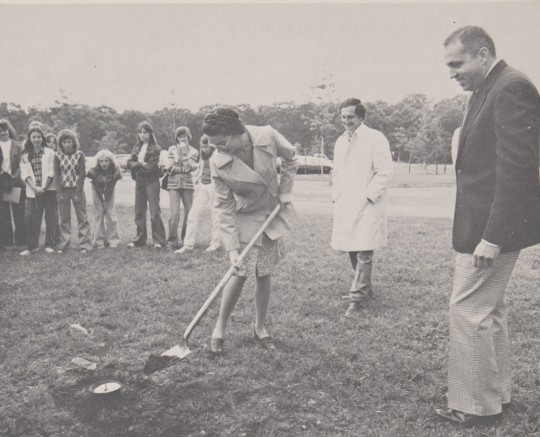
A self-described "Star Trek nerd," Barbara Scott's passion for space wasn't steered toward engineering by her guidance counselor. But that didn't stop her! Fueled by her love of math and computer science, she landed at Goddard Spaceflight Center in 1977. One of the first women working on flight software, Barbara's coding skills became instrumental on missions like the International Ultraviolet Explorer (IUE) and the Thermal Canister Experiment on the Space Shuttle's STS-3. For the final decade of her impressive career, Scott managed the flight software for the iconic Hubble Space Telescope, a testament to her dedication to space exploration.
Dr. Claire Parkinson: An Early Pioneer in Climate Science Whose Work is Still Saving Lives

Dr. Claire Parkinson's love of math blossomed into a passion for climate science. Inspired by the Moon landing, and the fight for civil rights, she pursued a graduate degree in climatology. In 1978, her talents landed her at Goddard, where she continued her research on sea ice modeling. But Parkinson's impact goes beyond theory. She began analyzing satellite data, leading to a groundbreaking discovery: a decline in Arctic sea ice coverage between 1973 and 1987. This critical finding caught the attention of Senator Al Gore, highlighting the urgency of climate change.
Parkinson's leadership extended beyond research. As Project Scientist for the Aqua satellite, she championed making its data freely available. This real-time information has benefitted countless projects, from wildfire management to weather forecasting, even aiding in monitoring the COVID-19 pandemic. Parkinson's dedication to understanding sea ice patterns and the impact of climate change continues to be a valuable resource for our planet.
Make sure to follow us on Tumblr for your regular dose of space!
#NASA#space#tech#technology#womens history month#women in STEM#math#climate science#computer science
2K notes
·
View notes
Text
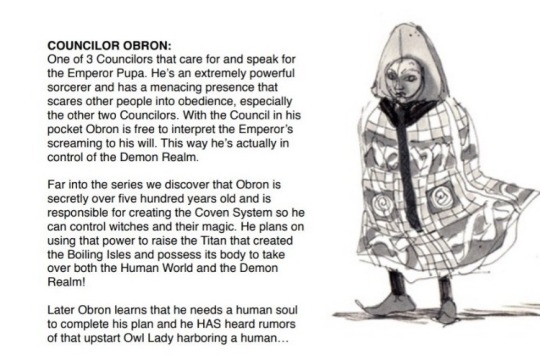
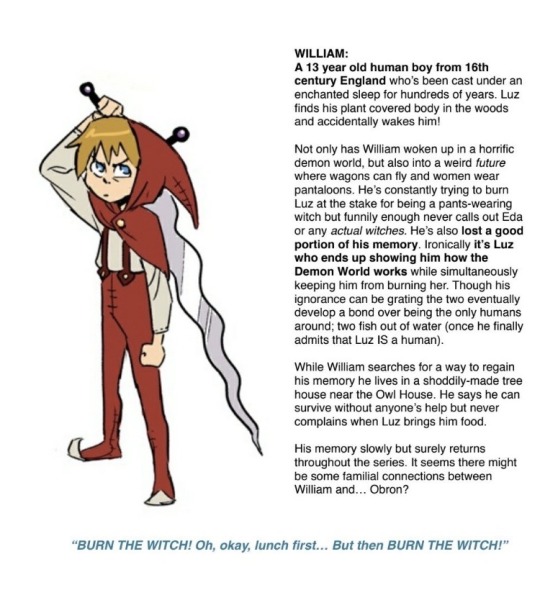
Speaking of; The Owl House's pitch bible got leaked as well! So while I look for the rest of it, let’s examine some interesting tidbits I found on Proto-Belos, or 'Obron' as he was once known, and William AKA Proto-Hunter!
Can I just say, I'm quite smug to know that Belos resurrecting the Titan as his endgame was always the original plan? I called it from the start! It was also kinda obvious, but c'mon. The Bionicle fan in me was obsessed.
I'm not surprised about the mentions of Pupa, or the name Obron or even the appearance; We've actually seen all of this before! But what does make me curious is the mention of two other councilors... So there's supposed to be a trio? Again, I always bring up the three statue motif in my speculation about the original plans of the show, I wonder if there's any connection there. Would Kikimora have been one of the other councilors, and who would've been the third? And it seems the coven system was always a thing, early on at least.
Yeah, the mention of '500 years' and the connection to William, etc. Even as Obron he was supposed to have been a human witch hunter turned actual witch. Comparing this to the pilot we got, it may not be Obron that the characters are referring to, since he's not the Emperor. But maybe he declared himself Emperor since he was basically the only one in charge by that point.
Makes me wonder if he hates humans under the delusion of 'I hate modern humans'. He hates what humanity has become and he's taking out his anger on modern humans; We also know the main reason he wants Luz in the pilot, to awaken the Titan. I presume Obron preserved William in stasis and hid him away, only for Luz to wake him up earlier than intended. I can imagine the scene/episode where Obron realizes William has been awake and roaming about for a while now...
There's the confirmation that Prince William and Hunter are the same character, or were. As I guessed, his witch-hunting tendencies would've been established early on as a strange gag, a quirk, only to become so much more darkly significant. I wonder if in this draft, Obron's past as a witch hunter also has relevance; Does he think he's 'saving' humanity by using the Titan to conquer both worlds, wiping out the denizens of one? Also him being a feral kid subsisting off of food given to him by friends is such Labyrinth Runners vibes. Was William always going to have his dynamic with Willow, given Luz plays a bigger role in him opening his mind?
Given we had a 'proof of concept' animation leaked a while back, I wonder if that was an even earlier draft to the pitch bible, given William is PRINCE William. Maybe he's meant to be an actual European human, because European bigotry towards witches existed back then I think, even if it wasn't as pronounced. And Obron does bear a resemblance to one of the Proto-Belos designs, though I'm not sure which came first.
…Huh. Would William have been Obron’s nephew or. God. Would he have been his brother. And while William never grew up because magical stasis, Obron did and now sees his brother be the exact same but also change. Man. And William just has to reconcile, when he gets his memories back, the jump from his brother, a kid like him, to Obron. So we still got the desperate attempt to preserve his brother, only for his brother/Hunter to ‘betray’ him.
219 notes
·
View notes
Text
Vil, Meleanor, and the Virgin Mary: Crowley’s Obsession
I haven’t seen anyone talk about this, but it’s driving me insane: Vil and Meleanor’s design parallel each other SO MUCH that it’s not even funny. In fact, I think Vil is foreshadowing EVERYTHING about Meleanor’s fate and Crowley’s plans.
I know I’m just coping lol, but I think I finally figured out why Crowley is so obsessed with the Fairest Queen and Pomefiore if he was Levan. Here me out: Vil is the representation of Meleanor.
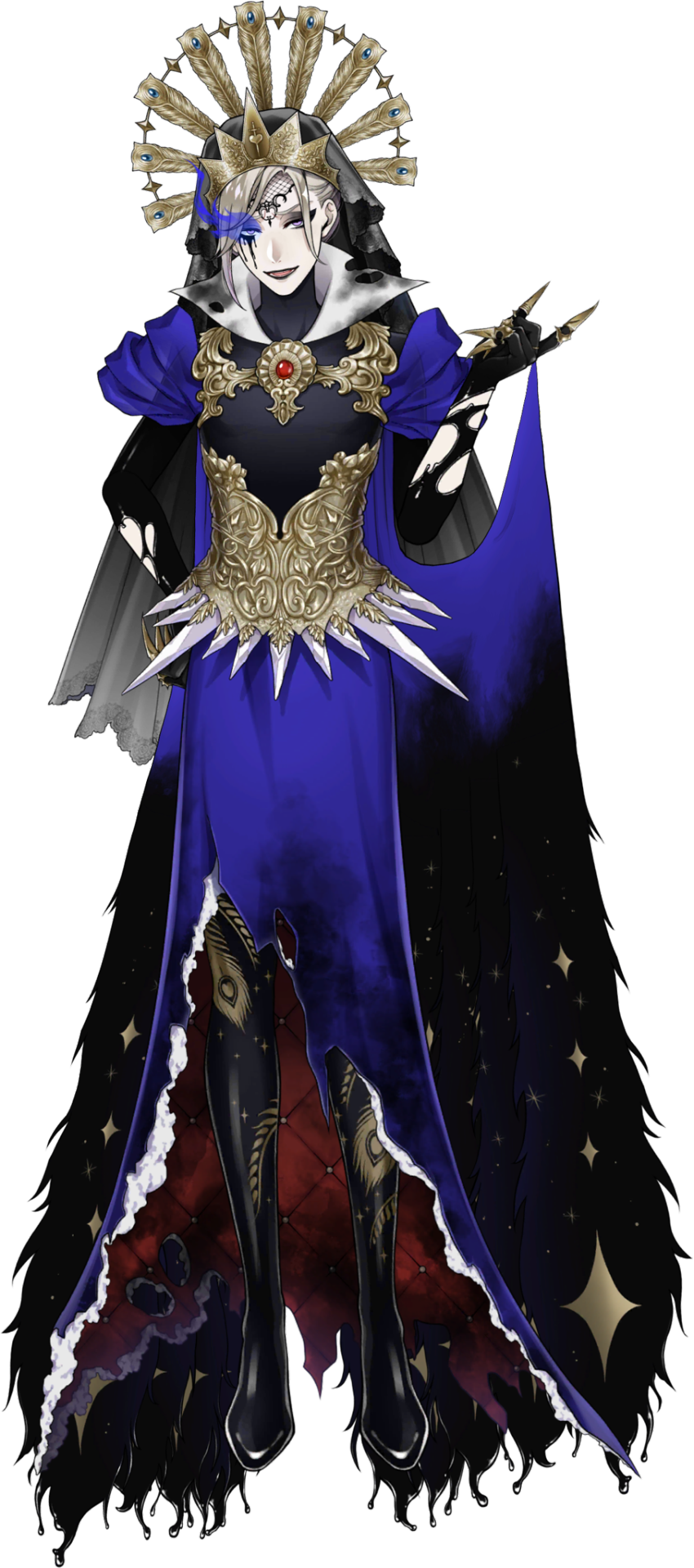

Vil’s Overblot form is what immediately caught my attention. The way his cape connects to his hands, the night sky on his cape, the corset and the gems. The way the edges of his dress looks like old, torn paper, like history long since forgotten. Not to mention how he has claws like Crowley and is wearing Crowley’s same exact shade of blue. Just…this entire silhouette with the sleeves and crown matches Meleanor more than Malleus’s Overblot does. Strange how both Vil and Meleanor are associated with stars, when Crowley has a lot of star designs on the curtains in his office.
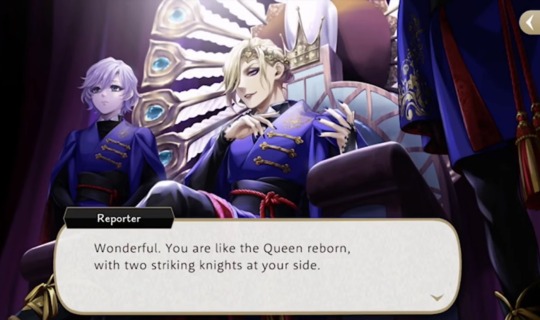
In his dorm uniform, look how the gloves and the lace has a similar design as Meleanor’s. Not to mention how in this vignette, Vil is like a “Queen reborn” with “two knights” at his side. Hm?? Like Meleanor with Lilia and Baul, perhaps?
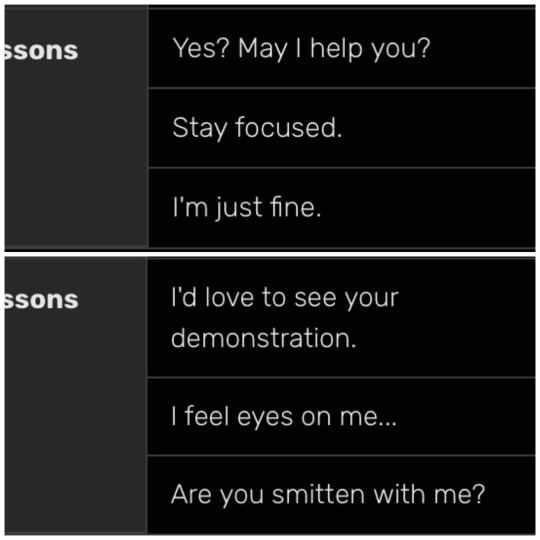
Something I’ve always found strange is how much Crowley dotes on Vil. In both his history and flight lessons, Vil comments a lot on Crowley when a Special Lesson is triggered. Doesn’t it feel…almost uncomfortable??? Vil feeling “eyes” on him specifically when Crowley is there. And there isn’t clarification if Vil is speaking to Yuu or Crowley, but when he says “I’m just fine,” it makes me wonder if Crowley was asking Vil how he was doing.
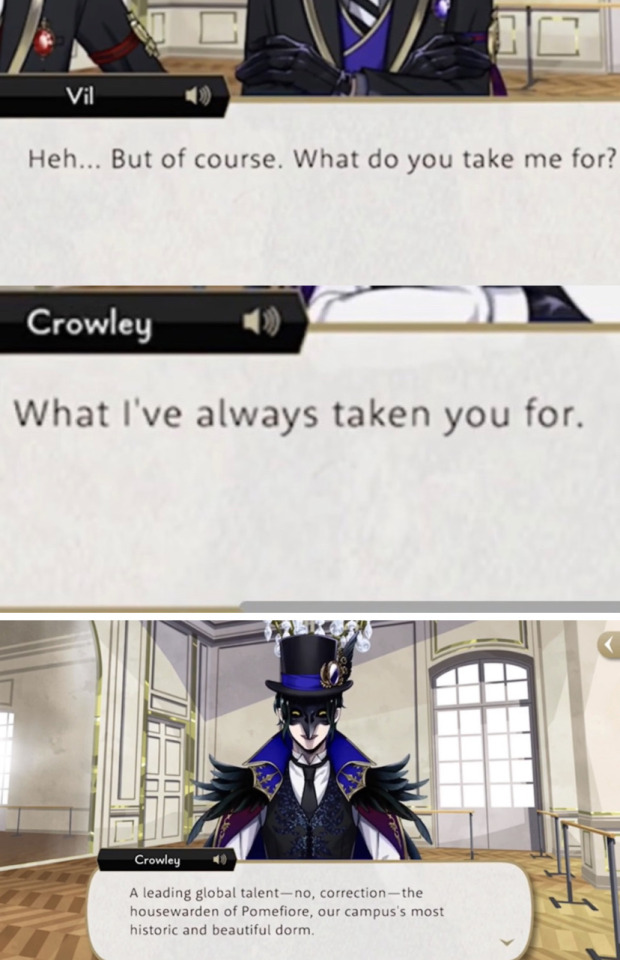
This isn’t just limited to the lessons. Although Crowley played a less significant role in Book 5 than I thought he would, doesn’t he sound very affectionate when he says this?? “What I’ve always taken you for”…he holds great pride in Vil and how represents the history and beauty of Pomefiore. Crowley has NEVER shown this much of a bias towards any student before. Only Vil.
I can hear some of you asking: Why in the world would Crowley/Levan care so much about Vil if MALLEUS and DIASOMNIA exists? Here’s the thing: Vil simply represents more of who Meleanor was as an evil, proud princess.

He is proud, he is beautiful, he truly understands the power of his beauty, how to make people submit to him with harsh truths. He has a certain charm and pride in his accomplishments that Malleus doesn’t.
But what REALLY got me was the religious symbolism in Vil’s Overblot form. @pianostarinwonderland made a really amazing post on the resemblances Vil has to the Virgin Mary and the Lady of Sorrows.
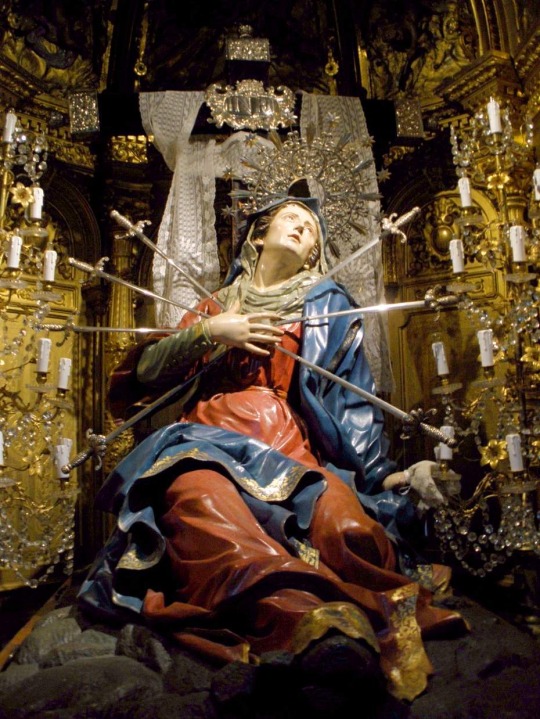
The Lady of Sorrows is another “form” of the Virgin Mary- which ironically enough, is depicted with SEVEN swords piercing her HEART. Sometimes she is depicted with only one sword- more on that later. The Virgin Mary is considered to be the holiest of saints- a figure of worship. She is also considered to be the “god-bearer.” Her death is referred to as the Dormition of the Mother of God, Aka the “falling asleep of the god-bearer.”
And back to the swords in her heart, the seven swords represent the Seven Sorrows, but the singular sword represents the Prophecy of Simeon.
The prophecy of Simeon said something like Mary’s child would be the RISE and FALL of many in Israel, and that a sword would pierce through Mary’s heart too, as an allusion to the crucifixion. Because Mary would suffer alongside her son, the one curse of motherhood. Stars are also significant in Christian mythology, like the star of Bethlehem to guide the wise men to the birthplace of Mary’s child. Another significant “star” is the Morning Star, Aka Lucifer. The Morning Star title is based off Venus, whose Greek name means “the light bringer” or “the DAWN bringer.”

If all of these things I’m saying reminds you about the imagery in TWST, I feel like this is purposeful! Lets back up and go over each of these points and how it relates to TWST (I am not religious, so if any of this is inaccurate, please let me know!)
Crowley in the opening seems to worship his “benefactor,” and I’ve been theorizing that it’s Meleanor whose trapped in the Dark Mirror. She is quite literally a figure of worship to him- the holiest of saints. And with Meleanor being the mother of Malleus, who is one of the most powerful mages in the world, doesn’t it sound similar to be a “god-bearer?”
The swords through her heart not only sounds like a connection to Meleanor’s death, but to Maleficent’s too. The sword of truth piercing her heart- but not only that, Vil’s Overblot crown LITERALLY has the design of a singular sword piercing through a heart. Yes, its a representation of the Evil Queen demanding Snow Whites heart, but why is Vil’s design combined with the Virgin Mary of all figures??

I bolded “prophecy” because I think Levan is heavily connected to prophetic powers, but doesn’t this prophecy sound A LOT like Meleanor’s blessing on Malleus? Malleus would be the benevolent star to the Fae, and an evil star to humankind. Like the Star of Bethlehem for the Fae, and the Morning Star for humans…and the Morning Star is heavily connected to the DAWN. Dawn Knight? Silver???
It doesn’t help that Dragon Fae seem to be ostracized by humans for their horns. Maleficent in Sleeping Beauty though, refers to her powers as “powers of Hell,” heavily leaning toward his demon like design.
Meleanor suffered to protect Malleus. She gave him up and fought an entire army to better his chances of survival because she loved him so much. And if Meleanor is trapped in the mirror and will be brought back to “life,” all of this suffering stemmed from the fact she sacrificed herself for Malleus.
SNDJDHSJSJDJD STOP IT TWST WHY DOES THIS ALL FIT TOGETHER SO WELL????? YANAAAAA HELP
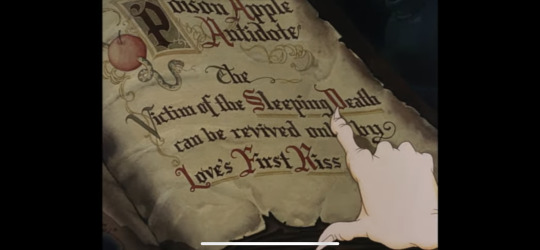
But do you see what I mean on how I think Vil is slyly foreshadowing EVERYTHING? Not only that, but look at his Overblot design again. At his waist, there are sharp crystal-looking objects surrounding him. I think these represent broken mirror shards. This, combined with all the coffin imagery at NRC, Epel’s Unique Magic, and Malleus’s making everyone fall asleep like Aurora or Snow White…
Perhaps Meleanor really is trapped in the mirror, put in a death-like sleep…but one day she will be freed, like Aurora or Snow White with the power of true loves kiss. Until then, Vil is the closest representation of her to Crowley. Someone who understands the power of beauty to make others submit, someone to worship.
#twst vil schoenheit#twst vil#vil schoenheit#twst overblot#twst meleanor draconia#twst meleanor#Meleanor draconia#twst Crowley#dire Crowley#twst levan#Twst levan draconia#twst dire Crowley#twst theory#twisted wonderland#KallistoPost#crowley is levan theory
886 notes
·
View notes
Text
JavaScript Fundamentals
I have recently completed a course that extensively covered the foundational principles of JavaScript, and I'm here to provide you with a concise overview. This post will enable you to grasp the fundamental concepts without the need to enroll in the course.
Prerequisites: Fundamental HTML Comprehension
Before delving into JavaScript, it is imperative to possess a basic understanding of HTML. Knowledge of CSS, while beneficial, is not mandatory, as it primarily pertains to the visual aspects of web pages.
Manipulating HTML Text with JavaScript
When it comes to modifying text using JavaScript, the innerHTML function is the go-to tool. Let's break down the process step by step:
Initiate the process by selecting the HTML element whose text you intend to modify. This selection can be accomplished by employing various DOM (Document Object Model) element selection methods offered by JavaScript ( I'll talk about them in a second )
Optionally, you can store the selected element in a variable (we'll get into variables shortly).
Employ the innerHTML function to substitute the existing text with your desired content.
Element Selection: IDs or Classes
You have the opportunity to enhance your element selection by assigning either an ID or a class:
Assigning an ID:
To uniquely identify an element, the .getElementById() function is your go-to choice. Here's an example in HTML and JavaScript:
HTML:
<button id="btnSearch">Search</button>
JavaScript:
document.getElementById("btnSearch").innerHTML = "Not working";
This code snippet will alter the text within the button from "Search" to "Not working."
Assigning a Class:
For broader selections of elements, you can assign a class and use the .querySelector() function. Keep in mind that this method can select multiple elements, in contrast to .getElementById(), which typically focuses on a single element and is more commonly used.
Variables
Let's keep it simple: What's a variable? Well, think of it as a container where you can put different things—these things could be numbers, words, characters, or even true/false values. These various types of stuff that you can store in a variable are called DATA TYPES.
Now, some programming languages are pretty strict about mentioning these data types. Take C and C++, for instance; they're what we call "Typed" languages, and they really care about knowing the data type.
But here's where JavaScript stands out: When you create a variable in JavaScript, you don't have to specify its data type or anything like that. JavaScript is pretty laid-back when it comes to data types.
So, how do you make a variable in JavaScript?
There are three main keywords you need to know: var, let, and const.
But if you're just starting out, here's what you need to know :
const: Use this when you want your variable to stay the same, not change. It's like a constant, as the name suggests.
var and let: These are the ones you use when you're planning to change the value stored in the variable as your program runs.
Note that var is rarely used nowadays
Check this out:
let Variable1 = 3;
var Variable2 = "This is a string";
const Variable3 = true;
Notice how we can store all sorts of stuff without worrying about declaring their types in JavaScript. It's one of the reasons JavaScript is a popular choice for beginners.
Arrays
Arrays are a basically just a group of variables stored in one container ( A container is what ? a variable , So an array is also just a variable ) , now again since JavaScript is easy with datatypes it is not considered an error to store variables of different datatypeslet
for example :
myArray = [1 , 2, 4 , "Name"];
Objects in JavaScript
Objects play a significant role, especially in the world of OOP : object-oriented programming (which we'll talk about in another post). For now, let's focus on understanding what objects are and how they mirror real-world objects.
In our everyday world, objects possess characteristics or properties. Take a car, for instance; it boasts attributes like its color, speed rate, and make.
So, how do we represent a car in JavaScript? A regular variable won't quite cut it, and neither will an array. The answer lies in using an object.
const Car = {
color: "red",
speedRate: "200km",
make: "Range Rover"
};
In this example, we've encapsulated the car's properties within an object called Car. This structure is not only intuitive but also aligns with how real-world objects are conceptualized and represented in JavaScript.
Variable Scope
There are three variable scopes : global scope, local scope, and function scope. Let's break it down in plain terms.
Global Scope: Think of global scope as the wild west of variables. When you declare a variable here, it's like planting a flag that says, "I'm available everywhere in the code!" No need for any special enclosures or curly braces.
Local Scope: Picture local scope as a cozy room with its own rules. When you create a variable inside a pair of curly braces, like this:
//Not here
{ const Variable1 = true;
//Variable1 can only be used here
}
//Neither here
Variable1 becomes a room-bound secret. You can't use it anywhere else in the code
Function Scope: When you declare a variable inside a function (don't worry, we'll cover functions soon), it's a member of an exclusive group. This means you can only name-drop it within that function. .
So, variable scope is all about where you place your variables and where they're allowed to be used.
Adding in user input
To capture user input in JavaScript, you can use various methods and techniques depending on the context, such as web forms, text fields, or command-line interfaces.We’ll only talk for now about HTML forms
HTML Forms:
You can create HTML forms using the <;form> element and capture user input using various input elements like text fields, radio buttons, checkboxes, and more.
JavaScript can then be used to access and process the user's input.
Functions in JavaScript
Think of a function as a helpful individual with a specific task. Whenever you need that task performed in your code, you simply call upon this capable "person" to get the job done.
Declaring a Function: Declaring a function is straightforward. You define it like this:
function functionName()
{
// The code that defines what the function does goes here
}
Then, when you need the function to carry out its task, you call it by name:
functionName();
Using Functions in HTML: Functions are often used in HTML to handle events. But what exactly is an event? It's when a user interacts with something on a web page, like clicking a button, following a link, or interacting with an image.
Event Handling: JavaScript helps us determine what should happen when a user interacts with elements on a webpage. Here's how you might use it:
HTML:
<button onclick="FunctionName()" id="btnEvent">Click me</button>
JavaScript:
function FunctionName() {
var toHandle = document.getElementById("btnEvent");
// Once I've identified my button, I can specify how to handle the click event here
}
In this example, when the user clicks the "Click me" button, the JavaScript function FunctionName() is called, and you can specify how to handle that event within the function.
Arrow functions : is a type of functions that was introduced in ES6, you can read more about it in the link below
If Statements
These simple constructs come into play in your code, no matter how advanced your projects become.
If Statements Demystified: Let's break it down. "If" is precisely what it sounds like: if something holds true, then do something. You define a condition within parentheses, and if that condition evaluates to true, the code enclosed in curly braces executes.
If statements are your go-to tool for handling various scenarios, including error management, addressing specific cases, and more.
Writing an If Statement:
if (Variable === "help") {
console.log("Send help"); // The console.log() function outputs information to the console
}
In this example, if the condition inside the parentheses (in this case, checking if the Variable is equal to "help") is true, the code within the curly braces gets executed.
Else and Else If Statements
Else: When the "if" condition is not met, the "else" part kicks in. It serves as a safety net, ensuring your program doesn't break and allowing you to specify what should happen in such cases.
Else If: Now, what if you need to check for a particular condition within a series of possibilities? That's where "else if" steps in. It allows you to examine and handle specific cases that require unique treatment.
Styling Elements with JavaScript
This is the beginner-friendly approach to changing the style of elements in JavaScript. It involves selecting an element using its ID or class, then making use of the .style.property method to set the desired styling property.
Example:
Let's say you have an HTML button with the ID "myButton," and you want to change its background color to red using JavaScript. Here's how you can do it:
HTML: <button id="myButton">Click me</button>
JavaScript:
// Select the button element by its ID
const buttonElement = document.getElementById("myButton");
// Change the background color property buttonElement.style.backgroundColor = "red";
In this example, we first select the button element by its ID using document.getElementById("myButton"). Then, we use .style.backgroundColor to set the background color property of the button to "red." This straightforward approach allows you to dynamically change the style of HTML elements using JavaScript.
#studyblr#code#codeblr#css#html#javascript#java development company#python#study#progblr#programming#studying#comp sci#web design#web developers#web development#website design#ui ux design#reactjs#webdev#website#tech
338 notes
·
View notes
Text
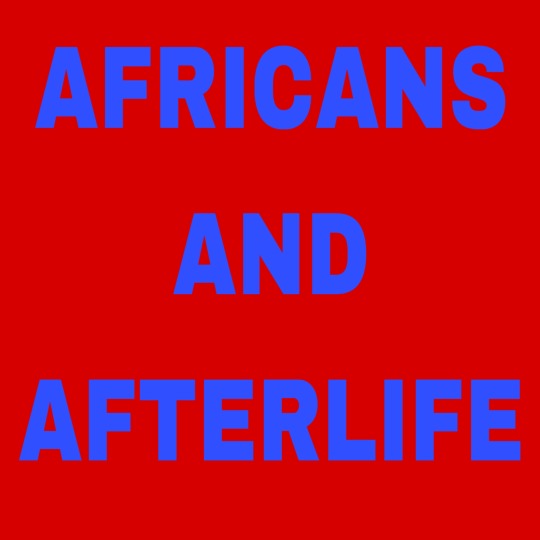
Diverse African Cultures and Beliefs about Life After Death
Introduction
Africa is a continent rich in cultural diversity and traditions, and this extends to its beliefs about life after death. Across the vast expanse of Africa, there are numerous cultures, each with its own unique perspective on what happens when life on Earth comes to an end. In this article, we will explore some of the fascinating beliefs about life after death that are deeply ingrained in African societies.
1. The Ancestor Veneration of the Akan People (Ghana and Ivory Coast)
In Akan culture, which encompasses the Ashanti, Fante, and Akuapem people, ancestors hold a significant place in the spiritual realm. They believe that after death, the souls of the departed continue to exist and influence the lives of their living descendants. Ancestor veneration involves rituals, offerings, and prayers to keep these spirits content and receive guidance and protection from them.
2. The Reincarnation Belief of the Yoruba People (Nigeria, Benin, and Togo)
The Yoruba people have a belief in reincarnation, where it is thought that the soul of a deceased person is reborn into a new body. The deceased's name may even be given to the newborn as a way of connecting the past and present lives. The Yoruba also believe that the deceased can communicate with the living in dreams and visions.
3. The Eternal Journey in Ancient Egyptian Culture (Egypt)
Ancient Egypt is renowned for its elaborate beliefs about the afterlife. Egyptians believed in a complex journey after death, where the soul faced trials and judgment before reaching the eternal paradise known as the "Field of Reeds." To ensure a successful afterlife, elaborate burial rituals and tombs were constructed, including the famous pyramids.
4. The Importance of Ancestral Connection in Zulu Beliefs (South Africa)
Among the Zulu people, the connection to ancestors is deeply cherished. It is believed that after death, the ancestors continue to play a role in the lives of their descendants. Rituals such as sacrifices and ceremonies are performed to honor and seek guidance from these ancestral spirits. Displeasing the ancestors can bring misfortune, while pleasing them can bring blessings.
5. The Dualistic Beliefs of the Dogon People (Mali)
The Dogon people have a dualistic belief system. They believe that after death, one's soul splits into two parts: one part goes to the ancestral realm, while the other is reincarnated into a new being. This complex system reflects the Dogon's spiritual connection to both their ancestors and the cycle of life.
6. The Spiritual Transition in the Akan-Bono Culture (Ghana)
The Akan-Bono people have a unique belief in the transitional phase after death. It is believed that after a person dies, their soul goes through a period of adjustment before joining the ancestors in the spiritual realm. During this time, the soul is thought to revisit important places and people from their earthly life.:
7. The Burial Rituals of the Senufo People (Ivory Coast, Mali, and Burkina Faso)
Among the Senufo people, the transition from life to the afterlife is marked by elaborate burial rituals. They believe that after death, the deceased's spirit lingers in the vicinity of their burial site. Special ceremonies and sacrifices are conducted to ensure a peaceful journey for the departed and to maintain a connection between the living and the deceased.
8. The Concept of the "Underworld" in San/Bushmen Beliefs (Southern Africa)
The San people, also known as Bushmen, have a belief in an underworld inhabited by spirits. After death, the souls of the departed are thought to travel to this underworld, which is considered a realm of ancestral spirits. The San people often use trance dance rituals to communicate with these spirits and seek guidance.
9. The Immortality Belief of the Himba People (Namibia)
The Himba people hold a belief that the spirits of their ancestors are immortal and continue to watch over the living. They also believe in reincarnation, where the spirit of a deceased person can be reborn into a new child within the same family. This belief reinforces the strong bond between generations.
10. The Role of Dreams in Khoikhoi Beliefs (South Africa)
The Khoikhoi people place great importance on dreams as a means of communication with the deceased. It is believed that dreams can provide insights, warnings, or messages from the spirit world. Special rituals are performed to interpret dreams and receive guidance from ancestors.
11. The Journey to the "Land of the Dead" in Dinka Culture (South Sudan)
Among the Dinka people, the journey to the afterlife is seen as a migration to the "Land of the Dead." They believe that the deceased will join their ancestors in this realm, where they can continue their pastoral lifestyle. Special rites and ceremonies are conducted to facilitate this transition.
12. The Symbolism of the Baobab Tree in Many African Beliefs
Across various African cultures, the mighty baobab tree is often associated with the afterlife. It is believed that these ancient trees serve as a link between the earthly realm and the world of spirits. Many cultures bury their deceased near baobab trees, believing that the tree's roots connect with the spirits below.
Conclusion
The intricate beliefs about life after death in Africa reflect the continent's cultural richness and diversity. From ancestor veneration to reincarnation, from underworld journeys to dream communication, these beliefs offer a glimpse into the deep spiritual connections that African societies maintain with their departed loved ones. Each culture's unique perspective contributes to the fascinating mosaic of African spirituality and traditions.
#life#animals#culture#aesthetic#black history#history#blm blacklivesmatter#anime and manga#architecture#black community
197 notes
·
View notes
Text
🪷 The Lotus Flower in Mysterious Lotus Casebook 🪷
i. Growing Deep Roots
As noted by difeisheng, Li Xiangyi is an image more than he is a person. He’s the “symbol” and “beating heart” of the Sigu sect; “he embodies everything [the sect] stands for” and “has become one with every person he represents” in his role as a leader. As such, one might say he doesn’t exist as an individual who’s allowed the luxury of flawed, fluid humanity. Rather, he’s fixed into an object: a shield protecting those under his care, a mirror reflecting those he’s taken upon himself to be the champion for.
While a heavy burden to carry, this identity as image is also shown to be brittle, hollow, like a hazy mirage which is more dazzling appearance than substance. Even Fang Duobing introduces Li Xiangyi to Li Lianhua by showing him a painting of his shifu — ink on a page, a person turned into a hero to be worshipped and idolated.
Li Lianhua, over the ten years that pass after the Great Battle of the East Sea, works to plant and cultivate a new identity in the same way one might grow flowers. Li Lianhua forms deep roots and grows out of the mythical hero’s shell he’d been carrying as Li Xiangyi, thus developing an identity which is solid and grounding in contrast — an identity which involves “walk[ing] within a crowd instead of [soaring] above it.”
This shift from image to person is itself rooted in the lotus mantra (written by Buddhist Layman Pang during the Tang Dynasty) which Li Xiangyi first encounters after monk Wu Liao rescues him:
一念心清净
莲花处处开
The heart attains peace with a single thought;
Lotus flowers bloom all around.
Although the exact timeline is left to interpretation, it’s implied that the lotus mantra operates as a catalyst of change for Li Xiangyi and that he changes his name to Li Lianhua after reading it. Now what is it about it that speaks to Li Xiangyi so deeply in that moment? As noted in 《 人間福報 》, the lotus mantra teaches us that a pure heart will result in an open and enlightened mind. One subtle, profound thought rife with compassion is enough for a person to glimpse Buddha in a flower, a leaf, a grain of sand or a speck of dust. In short, “if you can find peace within yourself, then you will find peace everywhere.” Perhaps Li Xiangyi, at his lowest point, finds solace in the prospect of stripping his life down to its very core and searching for purity, wisdom and peace within his troubled heart.
By renaming himself 莲花/liánhuā lotus flower, Li Lianhua takes his destiny into his own hands; he empowers himself into reshaping his identity and laying down the foundations for the person he wants to become. Similarly to The Yin-Yang Master: Dream of Eternity which tells us that “names are the shortest spells in the world,” Li Lianhua’s new name functions as a spell which speaks a new him into existence. It’s a deliberate choice, a conscious attempt at breaking free from the suffocating shell Li Xiangyi was trapped in and become a person of his own choosing.
The act of (re)naming notably also extends to Li Lianhua’s abode which he dubs 莲花楼 “Lotus Tower.” In addition to this significant choice of name, it’s interesting to note that Li Lianhua starts growing vegetables inside Lotus Tower when he’s left with nothing after his demise at the East Sea and is facing starvation. As such, his home is quite literally a site not only of self-sustenance and survival, but also of growth — a growth which requires hard work, patience and faith and nearly brings Li Lianhua to tears when his hopes are finally rewarded and the seeds he planted begin sprouting. The act of physically planting vegetables and learning to cook those vegetables speaks of a refreshing and grounding simplicity — of something disarmingly vulnerable and human after playing the role of a god-like figure. Li Lianhua has sweat on his brow and hope in his heart; he plants seeds, watches them grow and keeps himself alive by his own hands.
It seems it’s not only Li Lianhus’a home, but also his very person, which steadily grow into a lotus flower. Li Lianhua wears a variety of hairpins directly linked to the lotus, and the colour coding of his garments moves from the red he used to wear as Li Xiangyi to a lighter palette filled with greens and blues — colours which are more obviously linked to nature.
ii. Life Borrowed and Given Away
The lotus, both traditionally and within the drama itself, is closely connected to the theme of rebirth. On a literal level, the exotic lotus flowers of Cai Lian Manor grow directly from the corpses of the victims drowned in the pond, thus embodying life born from death. thawrecka writes in their story that Li Lianhua is “nothing but a lotus nurtured by a walking corpse, a body that doesn’t realise it should already be dead.” On a figurative level, the lotus grows in muddy water but blooms unsullied every morning, thus symbolising rising from a dark place and growing into something beautiful and colourful despite all the odds. The different stages of the lotus’ blooming can be taken to represent the beginning, middle and end of a spiritual path in Buddhism — a parallel to the theme of 趟/tāng taking a journey which underscores the drama in various ways.
Li Lianhua’s journey, more specifically, is that of a lotus being reborn. The soundtrack piece 《 一壶莲花醉 》 “A Pot of Lotus Wine” emphasises this connection in the following lines:
问一句莲花的悲喜
断一柄弃剑入青泥
I ask about the joys and sorrows of the lotus;
A broken, abandoned sword is thrown into the mud.
Not only does Li Lianhua keep stressing at different points of the drama that Li Xiangyi is dead and all that is left behind is Li Lianhua; he even breaks his own sword Shaoshi at the end of the story, thereby physically reenacting a process of destruction—death—and rebirth. As Li Lianhua writes in his farewell letter:
剑断人亡
My sword is broken, and I will be gone.
The significance of Li Lianhua’s action is further intensified here by the fact that the sword in the song is said to be thrown into 泥/ní mud, the site from which a lotus flower grows.
Considering that Shaoshi operates as a device embodying Li Lianhua’s character development throughout the drama, the fact that Li Lianhua decides to break it in the last episode should be taken as a key moment in which he chooses how his own narrative is going to end. Li Lianhua decides to kill for good the glorious image of Li Xiangyi which has become sullied with pain and regret in his heart, so that a simple, fragile peace can begin growing in its place like a lotus flower amidst the mud.
However, the tragedy of Li Lianhua’s narrative is that the rebirth he works to achieve for all these years is not his own to enjoy and never was intended to be. After the Great Battle of the East Sea, as Li Lianhua is reborn from Li Xiangyi and starts planting seeds all around him, he has already accepted that he’s nothing but a ghost, “wandering in the jianghu to close his loose ends and finally [...] vanish without a trace, not even a body left behind.” As mx-myth remarks, even the shift in his garment colours to an overwhelming amount of white as the story progresses makes it clear that he’s resigned to go and has “already started dressing for his own funeral.”
The lotus flower symbolism permeating the narrative accentuates this bone-deep, unshakable resignation. While imprisoned by Jiao Liqiao, Li Lianhua is full of an aching, bittersweet fatalism when he recites a section of Guan Hanqing’s《 窦娥冤 》“The Injustice to Dou E”:
花有重开日
人无再少年
不须长富贵
安乐是神仙
Flowers will blossom again,
But a man can never be young again.
Seek not eternal wealth;
You only need to be content.
Independently from the original meaning of the lines written by Guan Hanqing, the words seem to take on a sad, wistful quality when spoken with a bitter smile by Li Lianhua. In this scene, while the speaker reflects that rebirth occurs outside of themselves in flowers, they acknowledge that their own reality is one inevitably bound to end in old age and decay. Instead of looking forward to a bright future, the speaker doesn’t express any dreams nor ambitions and is only grateful that they’re alive this minute, this second, without any future prospects awaiting them. Perhaps a similar sentiment is reflected in the following lines from 《 一壶莲花醉 》 “A Pot of Lotus Wine”:
了了心事只
不负众生 而已
After settling my worries,
I just want to live up to all sentient beings.
Li Lianhua’s connection to the lotus flower, in fact, was always meant to be one of non-attachment. While Buddhism believes desire to be the root of all suffering, the lotus symbolises non-attachment due to being “rooted in mud (attachment and desire)” while “its flowers blossom on long stalks unsullied by the mud below.” This explains in part why the lotus is considered pure and noble. For Li Lianhua, this non-attachment takes on sorrowful connotations: it means that he stubbornly refuses to reap the seeds he sows and focuses his purest heart and will into ensuring those around him get to reap them instead. Non-attachment means allowing himself enough (a roof over his head, food on his plate) to survive, but rarely letting himself indulge in the precious luxuries of reciprocated love and care — of carefree joy and thirst for adventure.
The ten years he lives after his first death at the East Sea are, for him, only borrowed time he didn’t deserve — borrowed time not dedicated to himself, but rather dedicated to others.
In many ways, Li Lianhua’s path effectively goes full-circle by the end of the narrative. When he and Di Feisheng reminisce about the moon they remember from ten years ago, they conclude that today’s moon isn’t any brighter than the one alive in their memory: rather, it remains constant, unchanged, as though the past ten years never existed as anything other than a short pause in the story, a coma, long enough for wrongs to be righted but not for an already-dead person’s fate to be changed.
It’s interesting and particularly significant that the Styx flower (忘川花, from 忘川 “River of Forgetting” in the original Mandarin) is said throughout the drama to be the only thing capable of saving Li Lianhua’s life. In traditional Chinese culture, the Styx or River of Forgetting is part of the process of reincarnation; only by crossing it (and forgetting everything they’ve ever experienced and everyone they’ve ever loved) can a person finally reincarnate. For Li Lianhua, salvation through rebirth comes at a high cost — a price he’s evidently been ready to pay since the beginning, even if it means turning him into a ghost who must vanish from the story in order for those around him to grow and thrive further.
When Li Lianhua breaks his own sword to allow for rebirth, it’s not himself he’s saving. His sole purpose throughout his journey as Li Lianhua is to use whatever meagre strength he has left, whatever passion and drive are still alive in him, to save the world in any small ways that he can. He becomes a doctor who heals people; he looks for answers and solves mysteries to atone for the sins he thinks he has committed and rectify the mistakes he thinks he has made, so that those he has hurt can finally find peace and comfort.
The most powerful legacy Li Lianhua intends to leave behind by the end of the story has nothing to do with himself and everything to do with the people around him who he never truly admits he loves — the messy, imperfect world that’s caused him so much pain but that he nevertheless insists on saving with everything he has.
Most strikingly, Li Lianhua chooses—whether consciously or not—to leave the life and future he’s renounced for himself to his companions Fang Duobing and Di Feisheng. The only traces he purposefully leaves behind live in them: in the Yangzhouman coursing through Fang Duobing’s body; the home, dog and recipe book he passes onto him; the worthy opponent he leaves for Di Feisheng to fight in his stead after he’s gone…
Fang Duobing, by the end of the story, has grown into more than a disciple and a friend to Li Xiangyi/Li Lianhua: he himself has become the lotus flower bringing renewed life after Li Lianhua has left the narrative, thereby taking Li Lianhua’s legacy into a hopeful, vibrant future. As mx-myth mentions in their colour analysis, Fang Duobing notably wears bright pastel tones including a large amount of green/blue — a colour coding which emphasises Fang Duobing’s connection to spring and, by extension, new life and beginnings. “Life will always go on if there’s spring”; and so Fang Duobing’s youth, vitality and optimism can grow in the empty space left behind by Li Lianhua after he fades into the autumn of his life.
While Li Lianhua’s predominantly light colour palette might appear to align him with other characters in the drama who have left the past behind and are looking towards the future, Li Lianhua made peace long ago with the knowledge that he’s destined not to belong in that future. Just as the Lotus Sutra teaches us that “the inner determination of an individual has great transformative power” and “gives ultimate expression to the infinite potential and dignity inherent in each human life,” Li Lianhua focuses all his transformative efforts on creating a future which, despite having no place for him, will be fertile ground for the entire martial arts world to grow deep, healthy roots. In Li Lianhua’s own words:
幼芽生枝 新木长成
武林也一样
这未来如何
谁又能说得清楚呢
The young sprouts and the new trees grow.
The martial arts world is the same.
What does the future hold?
Who can say clearly?
Should we say, then, that Li Lianhua’s story is one of sacrifice, self-renunciation and resignation — of drifting inevitably towards death as a flower carried by a stream? As he disappears on a boat and is asked where he’s going, Li Lianhua gives a response which echoes his first death at the East Sea in a way that feels entirely deliberate:
小舟从此逝,
江海寄余生
From now on I would vanish with my little boat;
For the rest of my life on the sea I would float.
How are we to understand a person being reborn simply so they can pass on that new life to others, and being convinced that their only true value lies in their death?
Perhaps, in spite of it all, we can find some small comfort in the knowledge that, no matter how sorrowful Li Lianhua’s fate, it’s at least one that he chooses — one that he has full control over, even poisoned and robbed of his life force as he is. As the lyrics of 《 一壶莲花醉 》 “A Pot of Lotus Wine” underline, “it’s just a matter of picking an ending that you like.” Perhaps that’s all that truly matters.
wuxia-vanlifer makes an excellent point when asking: “What would be more tragic? That he never believed he was loved? Or that he did, but vanished anyway?” While I don’t have an answer to offer, there’s one thing I can say. Li Xiangyi, Li Lianhua — they live and die by love. They can’t conceive of themselves as anything other than a sacrificial tool because, for all that they pretend to be aloof and untethered, they actually love others—and the world—in a bone-deep, profound way they’ve never loved themselves. That love is not only the true driving force behind Li Lianhua’s character and the fate he chooses: it’s the beating heart of the entire drama.
“In this life, I have loved and I have been loved. That is enough.”
Shoutout to the following authors and bloggers whose brilliant words and ideas inspire me, as well as this gorgeous video 💖
ao3: @extraordinarilyextreme @thawrecka
tumblr: @difeisheng @extraordinarilyextreme @mx-myth @wuxia-vanlifer @xinyuehui
#mysterious lotus casebook#莲花楼#li lianhua#li xiangyi#cheng yi#fang duobing#di feisheng#it's sad nerd hours lmao 💕 now we can all suffer together 😘#i'd apologise for shamelessly referencing yym every chance i get even when it's barely relevant but.... well i won't 😌💅#also - please tell me if you notice errors or inconsistencies in any of my points ✨#although i'm always very thorough with my research i don't have a native person's knowledge of chinese language and culture#no doubt i'll think of lots of changes and additions i want to make once this is out there ssdhds 🥴 why is publishing anything so hard??#text: mysterious lotus casebook
80 notes
·
View notes
Note
Please tell me your serious thoughts on the Peter Pan crocodile!!
OH BOY. Alright. Okay. Hmmm
So there's a whole lot that I really can't disclose onto what I'm doing with it in The Novel because it plays a significant role in the prequel or sequel I'll tell my publisher I'm willing to write when they inevitably demand another installment, HOWEVER for the function of it as it exists within the story itself....
if I was directing a film or movie of it, I would want to keep it within semi-plausible parameters, but not make it a prehistoric croc.
It's a solid choice! To go with a living fossil like Sarcosuchus or Deinosuchus, because it's "real," but honestly...it's somehow less plausible than one that has simply managed to get to a fuck-off-big size.

Because yeah! I wouldn't want to be ANYWHERE near this thing!!! But I also don't think a kid chucking a hand in the water is going to be enough to bait one this size unless there's already blood/gore/bodies in the water that he's snapping at. True, this is not a story where logic prevails (hi, the acids in the guts of even a modern croc tend to destroy metals: jewelry, pieces of traps, animal tags, etc have all been found in them but VERY damaged/worn down. A clock is nothing, forget how you would hear it tick, it's just. anyway), however I'm not personally a fan of the "Somehow This Dinosaur Survived" genre of beasties, not when there are more things in heaven and in the earth.
SO.
Beyond the clock and the size, there is ...really nothing abnormal about it. The crocodile exhibits pretty standard behavior for a saltwater crocodile, the largest modern species (12-16ft is most common but some absolute monsters have measured in at nearly 20ft, and stories are everywhere about a mythic 25 ft)

If you grew up in the 1990s, you probably remember this guy wrangling them for tracking purposes. You can also see here what I was saying earlier: yes, they have an INSANE bite force, but their jaws aren't that tough otherwise--some rope, even around a big guy, is plenty to make the teeth less a concern. Then you just have to worry about their tails: solid muscle, which can propel them out of water like so:

Maybe he would have some more sympathy for the captain, given that he's also missing his right arm. If you've ever seen pictures of salties before, you've probably seen this one, or other pictures of him. This here is Brutus. He was, as of this image, estimated to be over 60 years old (!!!) and one of the largest living wild crocs. He's thought to have lost his arm to a bull shark when he was younger.
Bull sharks and salties do semi-frequently prey on each other: they both cross territories, though the sharks are primarily oceanic, and satlies (despite their names) are more common in rivers and brackish water. The reason they're called salties is that unlike most crocs, they CAN survive in saltwater. Again, we have a check in the box for old Tick-Tock, given that it seems to go inland on the island with some frequency.
If you've never seen a croc come out of the water before, it's Unnerving as hell. Watch any doc on the Nile, and you've seen a Nile croc (we'll get back to these) seemingly come out of nowhere and chomp onto a gazelle, but with salties it's somehow worse. The water just goes...still when they're gone. Like they were never there to start with.
Going off the book/play, a saltwater crocodile seems to be the most obvious, but again, we're running into size limitations. Reptiles never stop growing, and they certainly don't age the same way a mammal would, but they still do seem to have a lifespan under 100, and rarely break that 20ft limitation (with males typically getting larger than females of similar ages). It wouldn't be genetic impossibility to have one that had something going on in its DNA that made it BIG, at least not as unlikely as seeing a survivor from millions of years ago.
Plus, I do not care for the fact that the croc in the 2023 version seemed to eat anything that moved. It kind of defeats the purpose that this thing is after Hook specifically. And guess what? That's not impossible.
My only thing is...salties are my favorite, they're not related to dinosaurs but you look at this thing and the awe...

Look at him. He's a fucking dinosaur. The croc in the play/book/a film adaptation should, much like the ship, make you immediatley go "CROCODILE!" ...sleek, dangerous, fast, green, with fang like teeth. My brain always makes a crocodile green, and they're really not. None of them are. American alligators, the ones most prevalent in zoos when I was growing up in the US, are more often dark grey or even black looking in the water.
So that brings me back to this guy:

(that's a fish in its mouth, this individual is of a sane size)
The Nile crocodile. Confirmed man-eaters as well (I don't think I mentioned that, but salties are known man-eaters, there are some gnarly, tragic stories out there to complete with the grosses of shark attacks. Do not recommend research in this area), they're more known for this than their salty cousins. How much more well known?
Well. This guy is the responsible for more human deaths than we can even keep track of due to the remote locales they live. While I hate the idea of any wild animal being held up as villain, it's bonkers to me that we fear sharks as society rather than crocs since...Niles alone take down hundreds of people per year, instead of the 5-25 by all shark species combined.
True, they're freshwater beasties, but they can live in MILDLY brackish water. Its not something an animal can readily adapt to within its own life, but give a few generations to the ones that are currently invasive in Florida may eventually be able to cross to the Caribbean Islands.
They also have, and you can kind of see this in the skull structure, even weaker muscles for opening the jaws than salties.

You can put your hands around this thing's jaws (DO NOT. RECOMMEND.) and hold them shut.
More points in his box: Nile crocs had a uniquely nasty reputation in England following the Battle of the Nile in 1798, where crocs came rushing towards the violence and were picking off drowning and injured soldiers and eating bodies as they hit the water.

It was such a horrific sight that Nelson was presented with a gift sword that had one of the coolest design I've ever seen, though wildly impractical:

fabulous. look at that smile.
Anyway, the Nile Crocodile was the 'Jaws' of the mental menagerie of the Victorians. Barrie would have, when picturing a crocodile, very likely have been imagining one of these simply from how they became the stand-in for crocodilia in public consciousness.
Now it does lose some points not just for the saltwater issues, but because they only hit get around 15 ft, and Barrie's monster was big enough to eat a man whole even with some difficulty. In his notes for a silent film, he intended this be be shown on camera and it was frankly more traumatic than the 2003 film ending, of a mere snap of the jaws.
Side note: the 2003 crocodile is still under 30 ft, as is the 1953 one, it's just the skull/mouth proportions that make them seem MUCH bigger. Just like with sharks, the jaws of even a 20ft individual are going to be a LOT smaller than most people imagine.
The 2003 one works well enough, despite not seeing it very much (I have a WHOLE other essay on that--most of the set/props of the film we only get in small glimpses, giving it a dream/memory like quality where you fill in the blanks of a lot of what you think you're seeing. the croc included) but I kind of hate it's cartoony face:
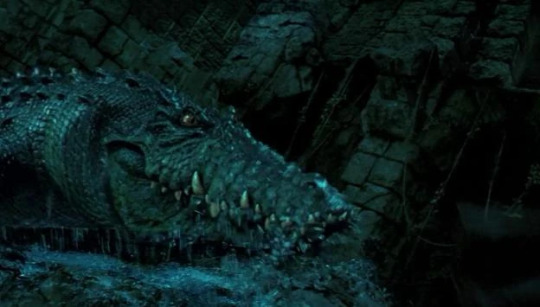
Genuinely, what the fuck is this thing even supposed to be. I appreciate that it looks almost demonic, an exaggeration of a crocodile--just as the ship was an exaggeration of a pirate ship, everything on the 2003 Neverland was taken to story-book extremes, making it seem all the more like a dream/tied to the imaginations of the kids.
MEANWHILE...Their concept art was better; this thing at least looks more like a croc than...whatever that thing was.
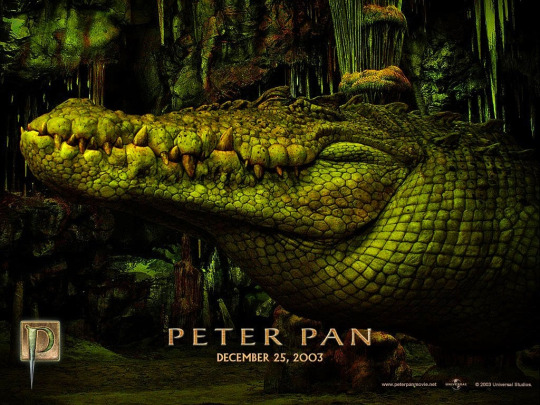
And of course the 1953 one is goofy, the entire movie was...well. Cartoony. The SyFy crocodiles fail to really drive home the scariest part of them, that they're intelligent enough to stalk an individual to the death, same as the 2023 one did: despite the whole "no one is safe from this thing" element that should raise the stakes, its just...not the same. [Though I HAVE seen an adaptation where the crocodile was after everyone but Peter and his friends, since it was HIS PET...the whole adaptation kept trying to keep the show from being too scary but ended up being one of the most disturbing Peters I'd ever seen].
All in all, despite the fact that I firmly believe a monster-sized Nile was the original vision, I'd be going with a salty, but the first time we see it, it would be covered in a slick of algae or weeds, giving it the green look everyone always pictures/draws/designs:

this isn't Brutus, but the guy on the left has a damaged right paw too--it's actually a fairly common sight on larger crocs, to see missing paws/damaged limbs from their various encounters with other predators, trespassing crocs, or boats/traps.
I had also put some thought into the possibility of a Cuban crocodile, American crocodile, and the Orinoco crocodile--the last of which may have once had expanded territory into the Caribbean, and historically had sailors claiming to see 20ft ones, although they typically measure smaller (and lighter) than salties today, under 15 ft.
Still, all this is irrelevant because peak character design for Tick Tock has already been reached:
I still haven't seen the movie, and I don't give a damn that this stupid thing was designed to sell toys, I have one that lives on my work desk and my evidence for why he's the superior Tick Tock is simply that he is the Bestest Boy.
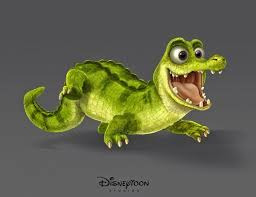
(concept art by Sona Sargsyan, I didn't see a credit anywhere for the concept art/promo image of the 2003 one)


Look at him. If this thing gave me those eyes and asked for a snack I'd start cutting off pieces of the captain myself. I mean not really, that's a bit bloody but you get the idea.
39 notes
·
View notes
Text
Momo's Snapedom AU Ask Game!
I do love how the Snapedom has folks who write extensive meta with citations and how the Snapedom has oodles of people making a delightful diversity of AUs that gnaw on the bones of the canon narrative skeleton to cook up a more satisfying story-soup!
So I thought it might be fun to put together a few questions for an ask game (after all, the fun part of fandom is interacting with other fans):
Do you have a name and/or a tag and/or a master post for your AU (so I can peruse your blog and admire your creativity)?
What is the premise of your AU (one sentence summary, tropes, your big “What-if” question, etc.!)?
Can you describe your AU badly? (Because I do love hilariously misleading but not actually inaccurate descriptions of stories)
What your favorite thing about your AU? (Does it make you cackle with glee or do you break your own heart?)
What are the major divergence points in your AU?
Is there any part of the canon narrative you really like to build off of or interrogate with your AU?
Are there themes or motifs or specific concepts in your AU that you hope people will notice? (Do you want to give hints about your masterful foreshadowing or chat about your extensive world building? Should we all grab a floriography dictionary when flowers are mentioned?)
What are some key life moments in your AU!Snape’s life that differ from canon!Snape’s life?
How and why does your AU!Snape differ from the canon!Snape?
Would your AU!Snape want to trade places with canon!Snape (and vice versa!)? Why?
Do you know if Severus going to escape the gravitational pull of the canon narrative/fate in your AU?
Do you think any other characters are going to escape the gravitational pull of their canon narrative/fate in your AU? If so, can any of that extra AU!velocity be attributed to Severus’ actions?
What era does your AU primarily take place in (is it focused on part of the canon timeline? Is the canon timeline adjusted a few years one way or another? Or are you playing with a futuristic sci-fi AU or a historical AU or something else entirely? Maybe you have a 1998!Snape dealing with life in 1942 or some other combination?)
What is his childhood and/or family life like in your AU? Is it better than his canon life starting out in Cokeworth?
Does Lily exist in your AU? Are Severus and Lily friends in your AU?
Do any of the Marauders exist in your AU? What role do they play in your AU Severus’ life?
Do the Malfoys exist in your AU? How do they interact with your version of Severus?
Does Voldemort exist in your AU? Does Severus join his cause at any point in your AU?
Does Dumbledore exist in your AU? What role does he play in Severus’ life in your AU?
Does Harry Potter exist in your AU? How does he interact with Severus in your AU?
Is there another canon character that plays a major role in your AU!Snape’s life? What role do they play and how does it differ from their canon relationship with Snape?
Is an Original Character a major feature and player in your AU? Who are they? What role do they play AU!Severus’ life? How do they interact with any other canon characters in your story?
Does Severus have a significant other (or others) in your AU?
Does Severus have children in your AU?
Is Severus Snape the Hogwarts Potions Master in your AU? If not, what is he doing instead?
Does Severus have any major interests (mycology, astronomy, sci-fi, baking elaborate puff pastries, art forgery, etc.) in your AU that we never got to see canon!Snape indulge in? Do these interests play a major narrative role?
Do you have a snippet of prose (or an art piece or a list of headcanons) from your AU that you particularly enjoy and want to share?
Free space! Any other questions folks want to ask?
#Severus Snape#Snapedom#snape fandom#snape community#prosnape#ask game#My questions are going to come from the main blog because I'm not tech savvy and didn't quite grasp what a sideblog was...#Canon is a scaffold and fanon is a funhouse mirror and I'd love to see what you're reflecting on!
42 notes
·
View notes
Text
pride & pettiness || jb22 series (1)
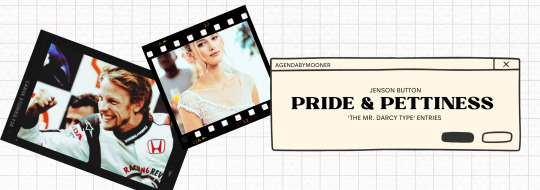
jenson button x ofc (british actress!ofc)
EXTENSION TO THE MR. DARCY TYPE (SMAU)
Summary: Ada James Abbott was an actress first and a writer second, but it seems like meeting a certain Jenson Button added more to her title as she learned to love and list down the most significant moments of her life with him.
OR her book, Mr. Driver, consisted of diary entries and memories that Ada remembered still to this day. These are the contents of the journals.
Content warning: Use of explicit language, Pride & Prejudice references, email exchanges, journal entries + scenarios (per time skip), fluff, yearning, Mr. Darcy & Lizzie Bennet dynamic (with a bit more humour and less aloofness), strangers to situationship to lovers??
Note: I’ve been talking to @daaiissyyyyy about sharing this thing because I have kept it in my drafts for a while. This may not continue or may continue but enjoy xx
a - n masterlist
o - z masterlist
i. 2004 In which, Ada and Jenson met for the first time. Also when the British actress found him attractive until he started talking.

JOURNAL ENTRY 1: SILVERSTONE 2004 — MR. HONDA DRIVER IS A HANDSOME GIT
I thought Hugh Dancy was the most attractive and insufferable man to have ever existed. But then my manager generously forced me to attend a race in Silverstone that eventually led me to some man named Jenson Button. He graced the grid with his boyish smile and his trademark charm that made me wonder if girls had ever fallen to their knees to be with him.
But his charm was arrogance in disguise. Who would have thought that a man so handsome could be stupid enough to downplay a stranger’s ability? Especially if he hadn’t seen enough of what I do? He doesn’t even know who I am and I don’t think that he is ever interested to know— but his jokes said otherwise. The endless flirting wasn’t the only thing that had my face flushing.
I probably overthink his jokes and had taken it to heart. But I can’t be blamed for that. He’s just attractive and I thought that he had potential. Then again, I shouldn’t expect too much from men.

SILVERSTONE, ENGLAND
Martin Brundle and his Grid Walk was the best part of the race; each celebrity or guest who graced the race with their presence loved having a conversation with him.
Ada James Abbott’s experience, however, was something of a memorable one. After all, meeting the most handsome man to have ever existed happened there. Live on the telly with his stupid attractive smile.
“The movie, King Arthur, is in its first box office week. You happened to play Guinevere,” Martin pointed out, making Ada nod and grin.
She stood next to him with all the smiles that she could offer — just happy to be recognized by someone in this industry of sports. The former driver then continued, “And you’re here in the grid now to spectate and enjoy the race— do tell: why were you not here the last time when the Pirates of the Caribbean movie came out? We were anticipating your appearance as you have obviously played the role of Elizabeth Swann. I was hoping to tell you more about what I thought of it.”
Ada giggled quietly before answering, “The schedule was quite tight during that time with having to go to tours and promote the film and filming other works in progress. We can absolutely discuss what you think but I do not think that it’ll be something that everyone would like to hear about on such a busy day!”
“Are you a fan of Formula One?” The reporter asked, a glint of curiosity washing through his features as he waited for the British actress to answer.
Ada then hummed, “It used to be something I watched. My father tried to rope me into watching it with him before, but it seemed to be only effective for my brothers Ralph and Nathan. I would watch at least… a race every month. It’s- yeah- it’s not something I would watch by myself so being here now and watching the real thing is an experience my dad would kill to see firsthand.”
“And you’ve met the drivers from the team you happened to be a guest in?”
“I did,” Ada replied with a nod, “David Coulthard, or DC— he insisted that I call him that— is a lovely man. He ran through the basics of his car and obviously had put up with my lack of knowledge in the technical aspects of the race. Kimi Raikkönen is a rather reserved one, and we’d obviously have to work on our relationship because of the lack of communication. Otherwise, it is amazing! I’m quite fortunate to be at the McLaren gar—“
“Would you look at that beauty!” Ada turned towards the direction of the voice and found herself staring at the facial features of the speaker.
A handsome man, he was.
“I think that you are speaking about yourself, Jenson,” Martin joked as ‘Jenson’ approached the two, now standing next to Ada as her face flushed red. “That head of yours would make the car lose its balance.”
“I didn’t say anything about myself,” Jenson scoffed playfully before peering down at Ada with a… smirk.
Ada lost all of her senses as Jenson began to speak, “‘Sides, if anything— this pretty face would make me lose my balance.”
“I assume that you’ve seen Ada James Abbott before,” Martin piped up, making Ada glance at the man and shift back to look at him.
She wasn’t able to see the handsome man, Jenson, next to her, but she could remember how the upper part of his race suit hung from his waist and how his eyes lingered on her.
What she wasn’t able to see however was the shaking of his head. Martin then continued to speak, “She’s quite an amazing actress, Jenson.”
“Is she really?” This comment had Ada turning as she looked at Jenson, whose smirk continued to grow while he spoke. “I’d believe any lie that you would tell me, especially if I’m being graced with your beauty.”
“What is that supposed to mean, exactly?” Ada spewed out, slightly baffled as he laughed heartily.
“I’m just saying,” Jenson winked at her, “I’ll believe it when I see a trophy, darling.”
With one comment, all the butterflies in her stomach had turned into something more sour. Ada Abbott’s smile turned strained as she only nodded before looking back at Martin Brundle. She wasn’t about to give this man the time of day right now. Perhaps he’d have to either retract his words or at least act like he just insulted her on live television instead of joking around like nothing happened.

JOURNAL ENTRY 2: EAT YOUR OWN WORDS, MR. HONDA DRIVER.
I just won my third trophy of the year. It’s quite amazing. But there’s something wonderful about making Jenson Button eat his own words. It was probably my pride that asked for his email address but sending him an image felt nothing of malice but satisfaction. God, did it feel so good.


TO BE CONTINUED
#formula one imagine#formula one fic#formula one x oc#jenson button fic#jenson button imagine#jenson button fanfic#jenson button#jb22#formula one au#formula one series#formula one fluff#f1 fanfic#f1 imagine#formula one#formula 1
103 notes
·
View notes
Text
RULES AND GUIDELINES

Unleashed! is an anonymous drarry + rare pair fest that welcomes works in which (an) animal(s), i.e. a magical or non-magical pet or beast, or an animagus or a patronus, must play a significant role.
We will be accepting drarry as well as rare pair fan creations.
For the purpose of this fest, a rare pair is defined as any pair, triad or poly relationship, except the first ten on this list. (Yes, drarry is in the first ten but it is an exeption.)
Accepted works include fic, art, craft, and podfic.
Timeline:
Prompting opens: May 1st
Prompting closes: May 15th
Claiming starts: May 16th
Claiming closes: August 31st
Submissions due: September 1st
Posting begins: September 15th
Prompting
You may submit as many prompts as you like, using your name or anonymously. You do not have to create for the fest in order to post a prompt.
Please include any extra prompt details that you would love to see incorporated. If you wish, you can also include maximum rating and any dislikes. Please note that these are for inspiration only and creators are not obligated to adhere to them fully.
We allow self-prompting. You can submit your desired prompt and then take your chance claiming it, or you can fill in the special box for self-prompts once claiming opens.
Prompts will be available for browsing once prompting opens.
Claiming
This is an 18+ fest. Please do not sign up if you are under 18 at the time of claiming (May 16th 2024).
You can only claim one prompt at a time. If you finish your prompt, you may claim an additional prompt. If you have finished your first prompt, and wish to claim another, please submit your first work as per submission guidelines before submitting another claim form. Claims will be awarded on a first come first served basis.
Collaborations are welcome. Please only submit one claim form per collaboration and include the details of all participants.
If you wish to create based on an existing fanwork, please submit it as a self prompt. We will only allow art, craft, or podfic for existing works with the original creator’s permission. We would expect written consent or a blanket permission statement from the original creator as proof. You can browse blanket permission statements of creators here.
Creating
This is an anonymous fest, so please keep the details of your creations to yourself. Please do not discuss your creations with anyone except for your beta readers and the fest mods until the reveals have been announced.
All creations must feature an animal as a prominent part of the work. This includes magical and non-magical pets and beasts, and an animagus or patronus.
For fics there is a minimum word count of 1000 words, no maximum. For podfics the recorded story should be a minimum of 1000 words, no maximum.
AI generated works of any format are not permitted in this fest.
All fics must be proofread. Podfics should be proofed before submitting. If you are unable to find a beta, please reach out to the mods.
Submissions must be complete works created for this fest. Please do not submit incomplete works or works that are a part of a series or a prequel/sequel to an existing work.
We encourage you to be inspired by the prompts’ additional details, but it is not a requirement to incorporate them into your creation. You are not required to abide by any mentioned dislikes. However, if you plan to gift your creation to the prompter, we may disallow this if you ignore stated dislikes.
Submitting
Due date September 1st
All works must be posted directly to the AO3 collection: Unleashed! Fest 2024. If you don’t have an AO3 account, please contact the mods in advance.
You are required to add unleashed_mods as a co-creator when uploading your work. This is so that we can change the posting date, check the submission, and add a tag for unleashed fest 2024 and an endnote. We will not make any other changes to your work without your permission, and we will remove the mod account immediately after the reveals.
Major archive warnings and other seriously triggering and harmful content must be tagged. Here is a very helpful list of warning tags. Given the theme of the fest, be especially mindful of tagging themes like animal abuse and cruelty, pet/animal death, bestiality, pet play, etc. The mods will proof all submissions and inform you if there are any additional requirements for the duration of the fest.
Upon submitting your content, you agree to the Rules and Guidelines of the fest.
Submissions for existing works should be linked to the original work using the AO3 function: “This work is a remix, a translation, a podfic, or was inspired by another work” and pasting the URL of the original work.
Following submission, please email [email protected] to confirm you have submitted your work and completed a submission header. You will receive a confirmation email from us.
Submission header
Title:
Creator(s):
Type (art, fic, podfic, craft):
Word count/length:
Art/Craft medium:
Warnings/tags:
Prompt number or self-prompt:
Pairing:
Summary:
Link to work:
Link to original work (if applicable)
Extensions/Dropping out
If you need to drop out for any reason, please let us know asap - life happens, we won’t be mad! We just need to know.
If you need an extension, please contact us with the estimated additional time you need.
Posting
We will post your creation on the scheduled day. We do not release the posting schedule as it is subject to change.
For any questions please reach out to us at [email protected]
From your unleashed mods @getawayfox and @stavromulabetaaa 🐾
27 notes
·
View notes
Text
I understand why it happens, but it's kind of striking how quickly fighting vampires on Buffy goes from being something that only the Slayer can do at all ("she alone will stand against the vampires", as the opening narration tells us in the first two seasons) to something only the Slayer can do well (meaning that other people can try but they'll risk getting hurt or letting vampires escape), to something that only the Slayer can be trusted to do properly (even if it might seem superficially that other people are doing okay) and then finally to something so mundane that pretty much anybody can do it, with or without any special powers.
The pair of mid-season 3 episodes I've reached during my current rewatch (Gingerbread and Helpless) almost feels like the last time that the writers will really take seriously the initial premise that being able to fight vampires is not something anyone can be expected to manage if they just put a little effort in. Both of them feature as plot points the idea that being able to fight vampires makes Buffy somehow uniquely special (which is perhaps one reason why Faith doesn't appear in either one of them). And yet, if anything , they already feel a little anachronistic at this stage in the show's history.
In Season 1 or early Season 2, the idea of Joyce accompanying Buffy on patrol as a sort of impromptu mother-daughter bonding event would have felt ridiculous (and not just because Joyce had no clue that Buffy was the Slayer or that vampires even existed) and it's clear in Gingerbread that we're still meant to think that it is. But it's a little harder to accept that when we've seen Buffy going on patrol while casually chatting with Willow just a couple of episodes earlier, or when we know that Willow, Oz and Xander spent all summer fighting vampires without sustanining any significant injuries. If it's okay for them, why can't Joyce tag along while Buffy's on patrol? (It's presumably not going to lead to her trying to burn her daughter at the stake every single time.)
Equally, the test that the Watchers' Council subject Buffy to in Helpless -- in which she is robbed of her powers and forced to fight a vampire without them -- is meant to be cruel and arbitrary. But by Season 7 the writers will decide that expecting a bunch of teenage girls with absolutely no special powers to be able to fight vampires is, in fact, a perfectly reasonable thing to do. And as the show progresses, more and more people without powers will do just that. Indeed, the conclusion of this very season will upend the show's premise by having Buffy's classmates take on a small army of vampires at their graduation ceremony.
In fact, vampires as a serious threat at all become increasingly rare in the show, starting from around this season. This season's main vampire adversary Mr Trick has been relegated to a subordinate role after less than a full episode on his own devices, and this is a role he will only manage to keep for a few more episodes. Despite a fun first appearance, Trick has never really managed to make an impression in the way that the Master or Spike or Drusilla or Angelus did. I'm honestly not even sure when exactly Buffy first learns his name. This season's Big Bad, the Mayor, is the first primary season villain not to be a vampire, and in fact no vampire will ever get to play this role again.
(Vampires in general start to become so quotidian and non-threatening that by Season 7 the writers resort to the rather embarrassing measure of introducing a brand new special type of really dangerous vampire, with decidedly mixed results.)
I might be missing a couple of names, but I think the list below covers every single speaking vampire character that appears in more than one episode of Buffy the Vampire Slayer.
Darla (first appears in Season 1, last appears in Season 1)
The Master (first appears in Season 1, last appears in Season 3)
Angel (first appears in Season 1, last appears in Season 7)
Luke (first appears in Sesaon 1, last appears in Season 1)
The Anointed One (first appears in Season 1, last appears in Season 2)
Spike (first appears in Season 2, last appears in Season 7)
Drusilla (first appears in Season 2, last appears in Season 5)
Dalton (first appears in Season 2, last appears in Season 2)
Lyle Gorch (first appears in Season 2, last appears in Season 3)
Mr Trick (first appears in Season 3, last appears in Season 3)
Wishverse!Willow (first appears in Season 3, last appears in Season 3)
Tom (first appears in Season 4, last appears in Season 4)
Harmony (first appears in Season 1, first appears as a vampire in Season 4, last appears in Season 5)
Sandy (first appears in Season 3, first appears as a vampire in Season 5, last appears in Season 5)
And what's striking about this list is that we have, less than a third of the way through the show, already met almost everybody on it. The only two recurring vampire characters with speaking parts who haven't appeared at least once already as of The Wish are Harmony (who we've met, but not yet as a vampire), Sandy (who we'll meet as a human in just a few episodes), and 'Tom', a character so unimportant I had to look his name up on IMDB because it is never spoken in the script for either of the two episodes he appears in. (He's one of Sunday's goons who's later captured by the Initiative, if you were wondering.) More recurring vampires have already appeared for the last time than are yet to appear, with still a hundred episodes left to go.
Yet, at the same time, (unnamed, mostly harmless) vampires will actually appear in almost every episode of Buffy until the show ends. Season 3 is actually the first season of the show to feature a vampire on-screen in every episode. The season where vampires appear least is actually the first: there are four episode of Season 1 with no vampires at all, and only three other episodes where that's true (one in Season 2 and two in Season 4). Perhaps that's why Season 1 is able to take them seriously as an obstacle.
Buffy will continue to be a show where vampires feature heavily after this run of episodes, but it won't ever really be a show where the audience is expected to find them particularly menacing. Even in The Zeppo, the very first episode after these two, it feels telling that the supernatural threat Buffy is worried about Xander being exposed to -- and the dangerous enemies she and the other Scoobies fight in the background while we follow Xander around town -- are demons, not vampires. Because as much as the show wants us to think that Xander is the "Jimmy Olsen" of the group, by this point it's stretching credulity to suggest that even he would be seriously troubled by something as unimpressive as a mere vampire.
62 notes
·
View notes
Note
Okay so a thing that has bothered me ever since I first watched Chat Blanc was Bunnyx and the general time travel stuff because tghis makes no sense. In the Chat Blanc time line, after Chat Blanc destroyes the universe, everyone is dead. Including adult!Alix aka Bunnyx. So the Bunnyx fron the Chat Blanc timeline doesn'rt exist anymore, meaning that the Bunnyx fron the episode is from a parallel timeline where Chat Blanc didn't destroy the universe. That however raises the question why she would even care about that other timeline. Is her quest to assure victory over Monarch in every single timeline because that sounds exhausting as hell. I also don't understand the deal with her leg disappearing while she witnesses the fight between LB and CB, it has no reason to, because LB defeating CB doesn't have any effect on Bunnyx because, as stated earlier, the Bunnyx from that timeline is already dead! And honestly, the fact that Lb even had to fight CB makes no sense. They could've just went back in time 2 minutes so LB can erase her name from the letter (or just be quicker so Adrien doesn't see her) and CB doesn't happen in the first place!
Like, genuine question, what was the point of the whole thing? I mean other than the concept is cool and the writers wanted to give LB trauma (which never really plays a significant part in the overall story anyway??)
Sorry for rambling so much, I don't know if this makes any sense, the episode was really confusing to me and idk if it's just because the episode actually doesn't make sense or because I just don't understand it bc time travel is really confusing. Would really love to hear your opinion!
You're fine and you're not missing a thing. The episode simply doesn't make sense nor am I sure why it even exists. I know a lot of people love it, but I really don't get the hype. It runs off of nonsense logic and makes most of the characters look really bad.
Let's start with the lore.
The canon lore is that Bunnyx only travels through time, not universes, so it makes no freaking sense that an adult Bunnyx would be able to stop Chat Blanc since the existence of Chat Blanc should stop her from existing. It's a total paradox that goes against everything we'd been told about her powers. Of course, she's also supposed to be the hero of last resort, yet we hear about her hanging out with famous historical figures and the season five final sees her acting as a substitute for the horse miraculous even though the people she portals in don't do a thing to help with the final battle, so it's not like Chat Blanc is the only time her powers and role get ignored. Any time I use the rabbit, I have to completely rework its lore because canon is just so bad at time travel. I like Alix and her adult design is awesome, but any time Bunnyx shows up, I expect to be annoyed.
Also, I will never forgive her for just dumping Ladybug back in our time without so much as a word of encouragement or any reassurance that the Chat Blanc stuff was only a maybe. And Ladybug was the one to figure out how to fix time!!! Alix, you suck at your job! Or this is just another case of the writers refusing to let someone other than Marinette save the day even though the poor girl really needs a day off.
As for why this episode exists? I don't even know, dude. It makes no sense. Back when we thought it was going to be a driving force in the season four conflict - an assumption that was backed up by Marinette's nightmare in sentibubbler - the episode kinda made sense in spite of its flaws. But we're two seasons past Chat Blanc and the only person who is apparently traumatized by it is Adrien.
Yes, the writers actually said this. No, you didn't miss an episode where Adrien learned about Chat Blanc. They were talking about the nightmares from the final:
Mélanie says that he "could become Chat Blanc" and the others add that even though he does not remember and has never lived it, Chat Blanc still has an influence on his actions.
Yes, this is embarrassingly bad writing. The character who never saw or even heard of Chat Blanc is somehow the one who is traumatized and effected by it while Marinette's trauma has nothing do to with Chat Blanc or the events of the season four final. Instead, it's random BS that was never even hinted at until season five. I just... what?
In case it wasn't obvious - which I guess it isn't given that professional writers missed this - the logical way to write this to have the season four conflict be about Chat Blanc from Ladybug's side. After the conflict ends, she reveals everything to Chat Noir who becomes terrified of hurting people with his powers. This is only exacerbated by the events of Destruction. But then the show would have had to let Chat Noir have a character arc that didn't revolve around Ladynette and the series seems allergic to that as a concept, so instead Adrien gets magical trauma that keeps him from the final fight. And I thought the Derision retcon was bad!
Other issues with Chat Blanc in no particular order:
It cements Nathalie as just as bad a Gabriel since she's the one who tells him Adrien's secret identity and we then see her do nothing to try to protect Adrien.
It makes Gabriel irredeemable by showing him gleefully hurting his child. Dude punts his son across the city with a smile on his face!
It makes Adrien look slimy since he asks Marinette out without telling her that he knows her secret identity. This one is in a bit of a grey area for me because the secret identity stuff is complicated, but Adrien has never been the one who cared about secret identities AND he's the one who has been directly turned down in hero form. The episode takes none of that into consideration with its writing and it really needed to for Adrien to feel like he had a valid point of view here. As is, he's taking advantage of a situation and putting his Lady love at risk for his own wants.
The pillow sniff scene makes Marinette look unhinged.
It spits in the face of The Power of Love by having Adrien's love fail to be enough to stop him from killing Marinette.
Marinette's parents should have gotten involved after Gabriel threatened her. There is no way in hell that I'd let my kid go over to the Agreste mansion after that. If the writers were once again determined to not let Tom and Sabine parent, then the threat should have come when Marinette was alone.
Why did Ladybug even need to go to the future if Bunnyx could have just gone back in time and stopped Ladybug from leaving the present for Adrien? Why did Chat Blanc even need to be defeated? What did Ladybug's ladybug actually fix when she cast her charm?
This is minor, but it bothers me: Chat Noir should not have been smiling and happy when he was freed from his akuma. That boy should have been in the middle of a breakdown.
I know people forgive some of the above because Chat Blanc is sort of an AU and I'm not going to say that's wrong, I just can't look at it that way because there's nothing that sets Chat Blanc apart from the normal timeline. The Paris special gives us an AU. Chat Blanc (and Ephemeral) are what the writers told us would happen in the canon timeline if Gabriel ever discovered his son's secrets. Canon Gabriel was the one doing those things and would have done them again if given the chance. This is who the writers said he is. Same goes for all the other characters who come across less than stellar here.
There's a reason why I love a good Chat Blanc rewrite. It's an idea with a lot of potential, but canon capitalizes on almost none of it.
25 notes
·
View notes
Text
[Trope Interest] Twin Bodyguards and Their Hunter Sister in Supernatural Works

Source: Promotional/Cover Art for Kyousougiga, Jiu Jiu, and Trese
By: Peggy Sue Wood | @pswediting
For some time, I’ve been fascinated by the trope of twin bodyguards who can shapeshift from humans to dog forms and their accompanying female “hunter” character. I find it interesting that this trope appears with enough frequency to be noticeable, yet it lacks a specific name, unlike “Single-Mind Twins” or “Tag Team Twins.” There are several examples of this trope. To name a few examples, Kyousougiga (Japanese) features the character Koto being followed around by her “brothers,” A and Un; Jiu Jiu (Japanese) has Takamichi followed by her shape-shifting, half-demon wolf-dog familiars, Snow and Night; and Trese (Filipino) has Alexandra with her adopted brothers, Crispin and Basilio.
Upon further review, I think that the trope of twin sidekicks/bodyguards and female hunters in supernatural comics and animation likely draws from various sources of inspiration and cultural mythology. One possible influence is the traditional Japanese folklore of “Inugami,” or “dog spirit.” Inugami were said to be the spirits of dogs that were killed by humans and were often summoned and used for various purposes, including protection, curses, and revenge. In some stories, Inugami could take on human form and even possess humans and other animals. Interestingly, these spirits could become attached to bloodlines, following a family through their descendants.
Another possible influence is the Japanese mythology of Komainu, lion-dogs that guard the entrances of Shinto temples/shrines, or the Shisa, which serve a similar purpose. Both of these seem to have derived from the Chinese (or Imperial) guardian lions, which symbolize protection (one physical and one metaphysical). Either way, around the world and over time, dog spirits have often been portrayed as both guardians and harbingers.
While I’ve come to understand, at least in part, the dog-twins potential origins, I still struggle to understand or find a related myth to a singular female hunter-type character. There is Artemis, the famous greek/roman myth character who is goddess of the hunt, but her image and story rarely overlap with the hunter characters seen in works that have this two+one combination. Moreover, the close emotional bond that the three tend to share in the stories–often portrayed with familial-nature (adopted siblings with no romantic interests)–seems to be a significant factor in the continued use of this trope. Continuing in our prior examples, Koto is searching for the black rabbit/her mother; Takamichi is hunting demons, and Alexandra is after monsters.
The twin sidekicks are always depicted as “protectors” or “guardians” to a female lead, often with her occupying an adopted sister role rather than existing as a love interest. They are portrayed as loyal, fierce, and powerful, with the ability to transform into large, intimidating dog-like creatures to defend their master. Overall, the dog servants are depicted as essential members of the hunting team and play a significant role in the story.
Of course, the influences behind Kyousougiga, Jiu Jiu, and Trese may have come from other supernatural comics and anime that have used similar tropes in the past. They may also have combined these cultural sources with their own stories to create a unique take. Regardless, it is an interesting trope to examine, and I continue to wonder about its specific origins.
If you have any ideas about the specific source(s) for this trope, I hope you will share them with me in a comment or message as I really do not know and am very interested to learn about this idea. Thank you for reading!
63 notes
·
View notes
Text
because some have proclaimed me as the bell-mère expert…
here are my thoughts on bell-mère’s role in the one piece live action adaptation.
tldr: i’m not happy.
i will preface by stating i am just Some Guy on the internet. do not let this rant negatively impact your opinion of the series. i thrilled with this adaptation!! i had a lot of faith it would be excellent going in so i wasn’t too surprised it delivered. it was comforting to kick back and watch such an incredible first season. i understand they had a somewhat strict timeline they could work from so certain characters and elements had to be cut. this is to be expected and i’m impressed with what they were able to squeeze in.
however. i am disappointed by only one thing. and of course, that one thing is bell-mère.
first, i will address characterization. or the lack thereof. seems like they stripped her entire character away by taking the time to bring her to life. if nami or nojiko explained what happened verbally, rather than sanction so much time and finances towards a flashback-style backstory, maybe they could've given bell-mère some individuality. that is mostly why i'm upset. bell-mère, to me, was one of the first interesting women in one piece. she got herself in trouble, she was violent, she was brave, but she was also a loving mother. we lost all her nuance bringing her to life. they captured only a small fraction of her character. to me, it felt like it wasn't even worth having a physical presence for this version of her.
in terms of her death scene, they took her fuckin' spine. she stood there in front of her kids, okay, she used her shotgun, that was nice. but her death was NOT it. it wasn't nearly as violent, gory and jarring as it was in the anime/manga. had such a low impact to me as a viewer. she just. got shot off-screen, and collapsed. she didn't try to recklessly fight arlong, she didn't face the entire crew. she didn’t put her gun in his MOUTH to BLOW HIS BRAINS OUT. that was the first time a woman in one piece, especially a former marine, fought so dirty. and they took that away from her. she seemed so docile so normal so. flavorless. not easy to remember or get attached to in the slightest.
i told a few people who only watched the live action adaptation that bell-mère was one of my favorite characters. they did not know who i was talking about. her name should be memorable. she should be memorable.
i understand power levels of the villains from what we’ve seen have been decreased. so some may argue if bell-mère DID put her gun in arlong's mouth, that would not end well for him. he was not shown to be capable of biting through wood or metal, after all. but i propose the suggestion that, if they put in the time and effort and stayed true to bell-mère’s character, they could have come up with another way to make her a true threat. that moment was simply not enough.
the death scene wasn't all bad though. she gave a nice speech to the girls, and although it still made me ask "bell-mère, why", it seemed a little more clean than her sacrifice in the manga? i did cry when nami and nojiko called her "mom", too. that was not in the original and cut like a knife. good play, opla. good play. i also liked bell-mère telling nami how she found them herself, it was nice to have that moment from the horse's mouth. the tangerine peel pinwheels were sweet but it signified the distinct lack of genzo. which also made me quite sad :(
i will reiterate: i am very happy with opla, and very happy bell-mère existed. but i almost would rather her be a dialogue-given backstory if it restored her character. nami’s backstory felt weak as a result. imagine how much harder the new viewers would cry for bell-mère’s death if she had zeff-level complexity. she hit nami before the runaway scene, but that was not enough to reveal anything significant about her. she was a little stern when nami took the book but that wasn't the right impression, either. bell-mère isn't stern. she's a very casual parent with a temper. without seeing that side of her, the slap kind of played off as random, or even cruel. that was a big character-development moment for her!! but she dies and zeff lives so i suppose there's no point adding too much depth to her. there was never a point in this season where i was like "this is a waste. we could use this time for bell-mère instead." everything felt necessary. so it's okay. she did what she does best and she took the sacrifice.
in the meantime, i’ll keep writing stories for her ♥️ if you liked this mess of a rant, here’s an analysis i threw together about her role/death in the anime. maybe that’ll make my disappointment feel even more warranted XD
love you all and i love you too opla 🥰
#one piece analysis#opla#opla spoilers#one piece live action#arlong park#arlong#bellemere#bell mere#bell mère#nami#one piece rant#gen is mostly venting#genzo#nojiko
67 notes
·
View notes
Text
The Locked Tomb Series Name and Symbolism #3
This one is a beast. Be warned.
And now, onto the original Penumbral Lady, the Mother of the 9th House, the First Keeper of the Tomb, the Lyctor that that never was, Anastasia the First.
Now Anastasia is one of the characters most riddled with symbols and hidden meaning and conspiracy theories, so I'll do my best to add my own tidbit here.
The studious over-researching scion of the Ninth House has ended up being a Symbol herself, in a way that all saints are to those that love and follow them. And the Ninth does love her, or at least, they love what they understand, what they perceive she stood for (The Anastasian monument and the whole "You could not trip in the Ninth House without falling over an Anastas, an Anastasia, or an Anastasius; or, in later years, bumping into their niche.")
But here we'll look into more mundane, if you will, aspects of her symbolism and perhaps come up wit ha theory or two on the way.
First things first, her name itself. Anastasia or Αναστασία is a name of Greek origin that is quite popular in Eastern Europe, and closely associated with Christianity (You'll be surprised at how many Saints of the Orthodox Church have born that name. Okay it's five, but it still seems a lot) It originates from the ancient Greek word ἀνάστασις, meaning Resurrection. The noun itself comes from the compound verb ἀνίστημι, which for our language nerds such as myself out there has two components ἀνά meaning again and ἵστημι meaning stand. So practically, stand again, which is my personal favorite take on the name. Being the one that stands up again, and again, and again. Beautifully stubborn, don't you think? And quite fitting for our Saint here, for research is nothing but failing and falling down time after time only to rise back up wiser than before and face the challenge again. In all honesty, this also reminds me of a few other Ninth House dolts, that redid that trial countless times without any sleep, food whatsoever. For all my experimentalists and researchers out there, do NOT be like Harrow. A few hours of sleep, or a walk down the hallway and a glass of water might help you figure it out, more than tiredly redoing the same thing over a thousand times. Oh, I am off track though, I apologize.
Back to our point, Anastasia = Resurrection. Now whether that resurrection refers to her own coming back from the dead (we see Alecto recognizing her bones huddled in a corner ready to roll the stone back up) or perhaps another Second Resurrection, with John overthrown and things returning to their natural order - more or less, kinda, I mean who knows?- and her or her blood aka Harrowhark playing a significant part, I don't know.
What we also do not know, are the exact circumstances of her existence post ascension attempt, and the manner of her death, both of which are clouded in mystery. Kind of like another Anastasia in history. Yes, that's the one, Grand Duchess Anastasia Nikolaevna of Russia. Countless rumors of her possible escape circulated after her death, fueled by the fact that the location of her burial was unknown until even decades later. And still even after the mass grave was found, the bodies of the young tsarevich and one daughter were missing. (Those were found in 2007 and the body is attributed either to Maria or to Anastasia). Another Anastasia that for decades was clouded in mystery.
But mysteries are kind of a Ninth House thing, aren't they. What with the jawless skull, the only known treatment to a sewn tongue being the house symbol and all. And my gosh, the whole thing with Alecto has my brain spinning. Because why would John ask of Anastasia to guard Alecto in the tomb? Why would he sent his only failed student, the one he betrayed, with the thing that could spell his end? Why lock them up together? Unless the point was not to give Anastasia a role, but to punish her.
According to the eighth as they so graciously inform us, the Ninth shouldn't even exist. Anastasia should have sealed herself with Alecto in the tomb and died there. There was no plan for her having descendants, a bloodline unbroken for ten thousand years (Why, I wonder? What did it service? Why was it so important and so deeply integrated in the Reverend Family that Harrow's parents had to go to the lengths they did to ensure the continuation of Anastasia's bloodline? To ensure, unknowingly that the oath between Anastasia and Alecto still held true?)
Before diving to my own conspiracy theory about these questions I would like to point out a parallel between Anastasia being locked as a punishment in the tomb and one of the most well known tragedies of the ancient Greek world. It could be none other than Sophocles' Antigone. And again the parallel between Antigone and Anastasia is so prominent as the Alecto Αληκτώ one, that having translated the part
Ὦ τύμβος, ὦ νυμφεῖον, ὦ κατασκαφὴς
οἴκησις αἰείφρουρος, οἷ πορεύομαι
πρὸς τοὺς ἐμαυτῆς, ὧν ἀριθμὸν ἐν νεκροῖς
πλεῖστον δέδεκται Φερσέφασσ’ ὀλωλότων·
ὧν λοισθία ’γὼ καὶ κάκιστα δὴ μακρῷ
κάτειμι, πρίν μοι μοῖραν ἐξήκειν βίου.
Ἐλθοῦσα μέντοι κάρτ’ ἐν ἐλπίσιν τρέφω
φίλη μὲν ἥξειν πατρί, προσφιλὴς δὲ σοί,
μῆτερ, φίλη δὲ σοί, κασίγνητον κάρα·
I don't know how many times, I should be ashamed of myself for not making the connection sooner. Our Greek speakers have probably already figured out the translation, but lets put it here as well... this is the most famous
Ω Τάφε μου, κρεβάτι νυφικό, σπίτι μου
στη βαθιά τη γη κι αιώνιο κελί μου,
έρχομαι να βρω τους δικούς μου νεκρούς
που μέγα πλήθος η Περσεφόνη φίλεψε...
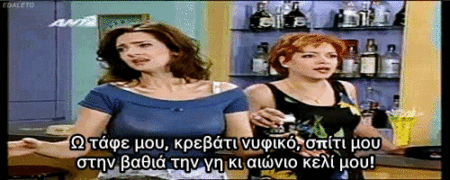
(I am cutting this short, we will need the English version either way. Don't ask why this part is such a big deal. It just is)
Anyhow, for everyone else that didn't grow up around Greek comedic series of the 90s this whole thing translates to
O tomb, my bridal-bed—my house, my prison cut in the hollow rock, my everlasting watch! I'll soon be there, soon embrace my own, the great growing family of our dead Persephone has received among her ghosts. I, the last of them all, the most reviled by far, go down before my destined time's run out. But still I go, cherishing one good hope, my arrival may be dear to father, dear to you, my mother, dear to you, my loving brother...
And while the bridal bed line would make for an interesting interpretation, seeing Harrow's -Anastasia's blood, instant pull to Alecto and seeings as we never figured out the nature of the relationship between Alecto and Anastasia, it is the greater premise of the story that we care about.
In short, Antigone had two brothers, who fought over who could rule over Thebes. So evenly matched they were, that they both perished in the fight, and Antigone's uncle, Creon, takes over. Eteokles (Ετεοκλής) who stood for Thebes was buried with the honors befitting a king. His brother Polyneikis (Πολυνείκης) however was left out of the city borders, exposed to the elements, his body abandoned to be consumed by vultures. Creon ordered that no one was under any circumstances allowed to give Polyneikis any sort of death rites, and going against this order was punishable by death. If you know your way around Greek myths, you know that is the worst thing you could do to someone, and it was considered a heinous crime both by mortals, and most importantly, the gods. Antigone, defies Creon's order to not bury Polyneikis and performs the rites symbolically, applying a thin layer of dirt on her dead brother's body. Creon finds out, and after his son begging him for Antigone's life instead of her being killed by stone throwing, Creon decided to bury her alive in a cave with no food or water, until she died of thirst and hunger. Thus the tomb, and prison Antigone mourns about. The story does go on, and ends up with Antigone being found dead, having taken her own life in the tomb, Creon's son, who was in love with her trying to kill his father, failing, and killing himself, and Creon's wife Euridice, killing herself at the loss of her only son. Creon then exiles himself from Thebes cursing his own αστοχασιά, foolhardiness and imprudence at not following the moral laws and the will of the gods.
Antigone chooses to go against man-written laws, and the power of the mortal king, in order bury her brother, following the divine honor and will of the gods, as well as her love for her brother. In return she is punished by being buried alive where she chooses to end her life and meet her family in the Underworld.
The parallel to Anastasia is rather prominent in this case. Anastasia in attempting perfect Lyctorhood goes against John's will, something however that she didn't know, and John himself didn't realize probably until the oh crap she is going to achieve perfect Lyctorhood, and my mistakes will be obvious for everyone to see. Doubt is going to enter everyone's minds and then I will have lost them all over again.
So he kills Samael - again, I think that something might indeed have gone wrong in the process and Alecto might have been involved with or without John's urging, but that' s a story for another time. And Anastasia is all that remains, brokenhearted and unwhole. He doesn't kill her and she lingers, probably doubtful and distrusting. Then she is tasked with guarding Alecto's tomb until her death. John seals Anastasia in the tomb, much like Creon seals Antigone, because she went against his will. Whether that is because of perfect Lyctorhood or some later transgression - a potential pact/ blooming friendship with Alecto, we don't know.
John like a petulant child, locks his broken toys away, where no one but him can find them, where nothing but his blood can free them. Anastasia like Antigone, follows rules larger than her small king, and is entombed with the body she is supposed to protect as a result. She makes peace with her death, does not cling to life, seemingly already having met Samael in the life after (if he is indeed dead)by the time Alecto is freed and tastes her in Harrow's blood. She is naught but a pile of bones ready to roll the stone and seal the tomb once more. John's intentions were never for her to have descendants, for the ninth to become a house. It was to lock the women who he left behind, whose trust he betrayed, for eternity. To keep their doubts, and their secrets and power forever buried.

#alecto tlt#harrow the ninth#the locked tomb#harrowhark nonagesimus#tlt series#tlt spoilers#anastasia the first#anastasia the ninth#samael novenary#nona the ninth spoilers#locked tomb#john gaius#alecto the ninth#literary parallels
28 notes
·
View notes